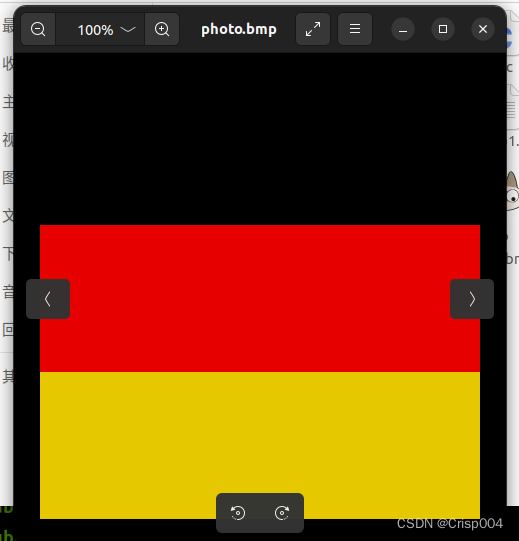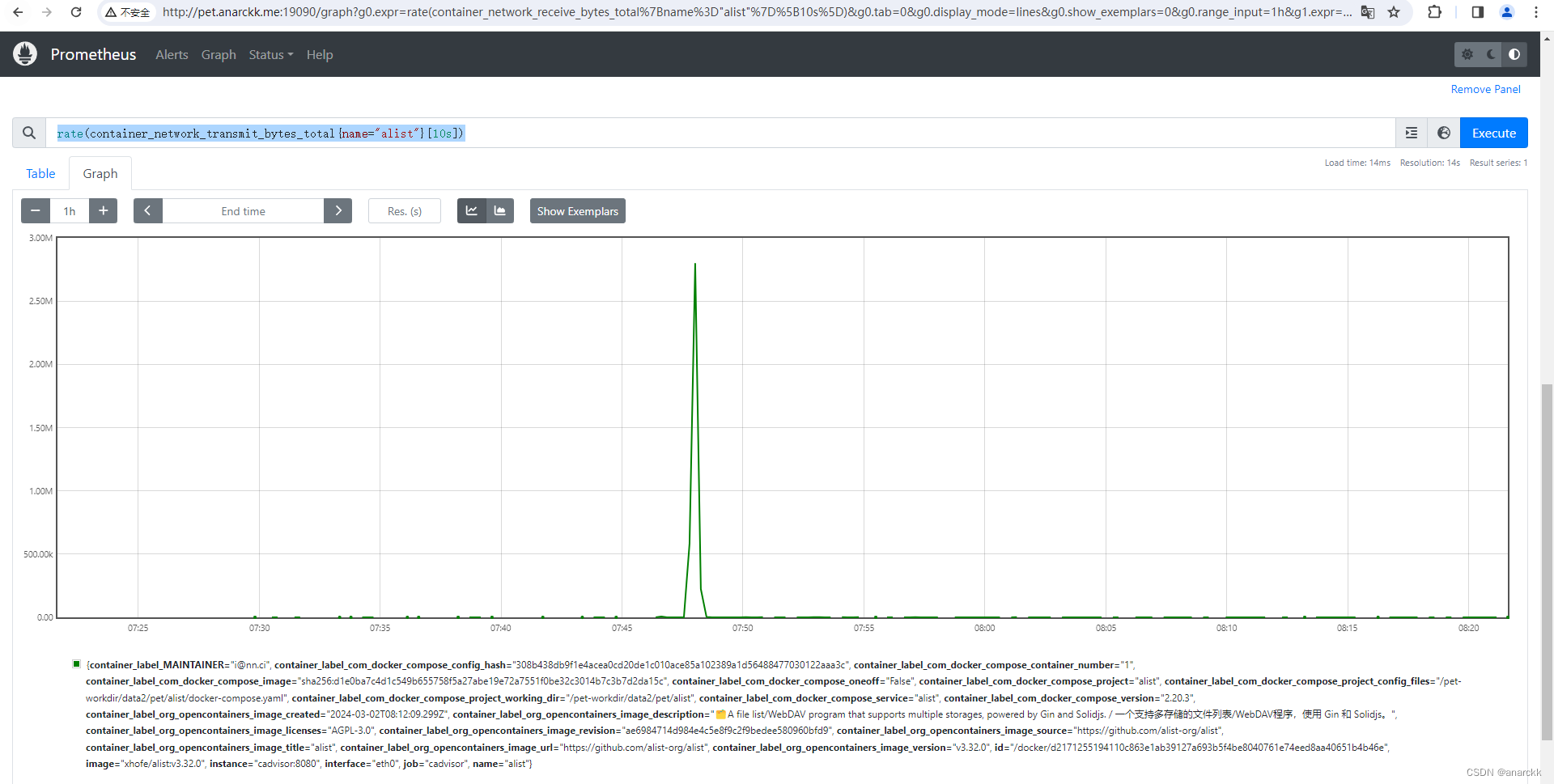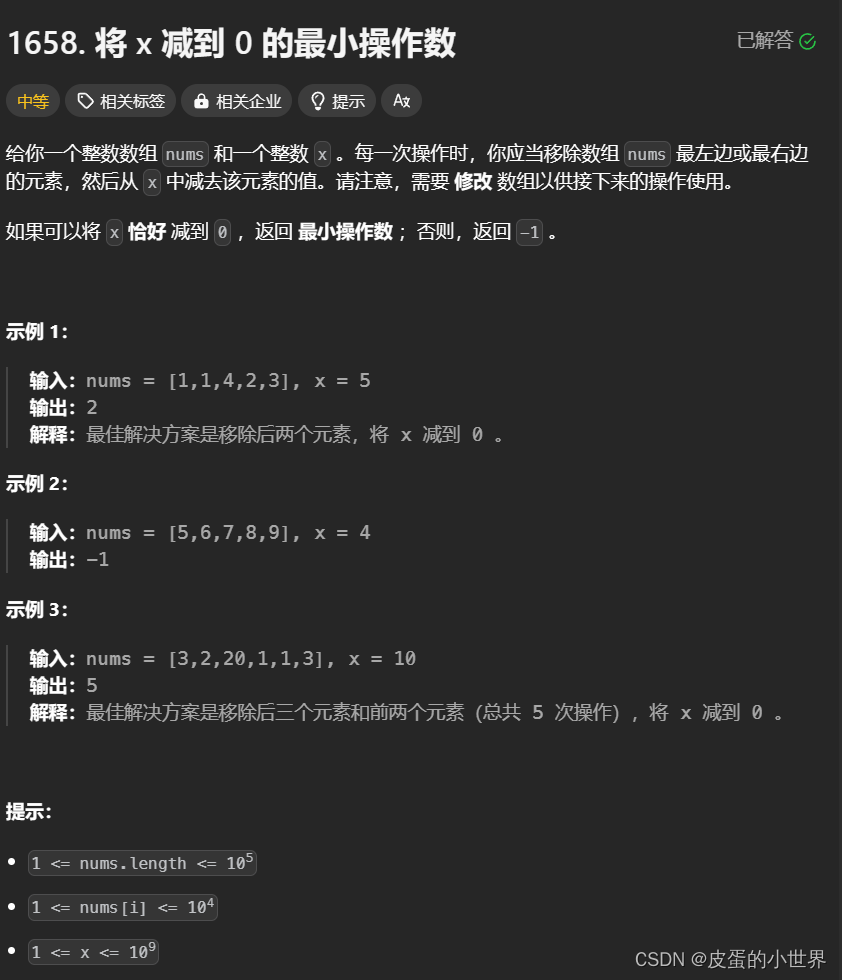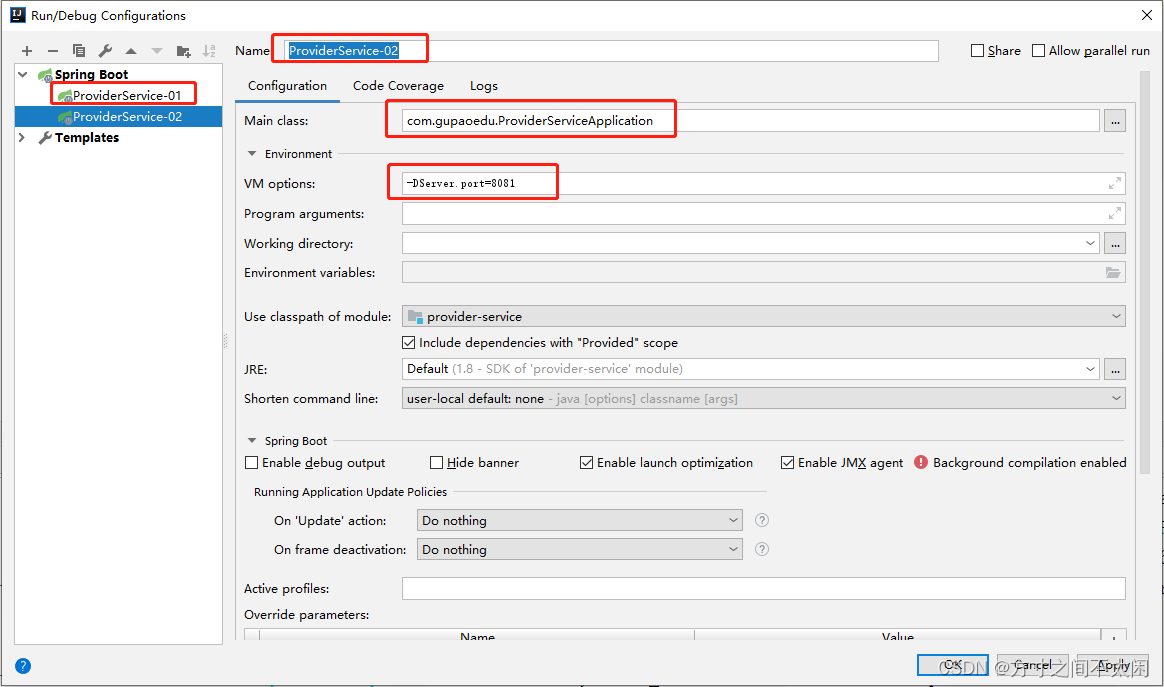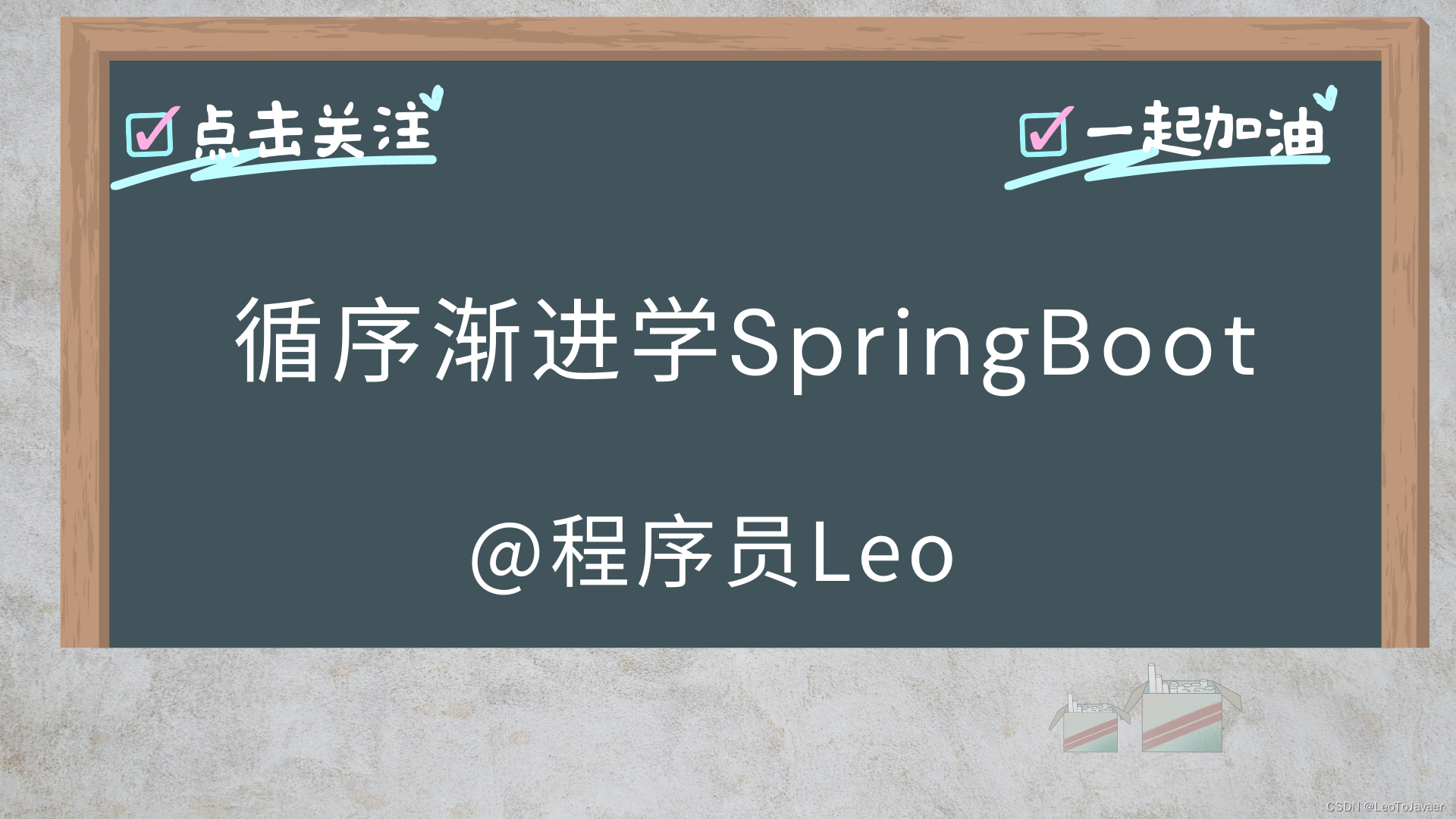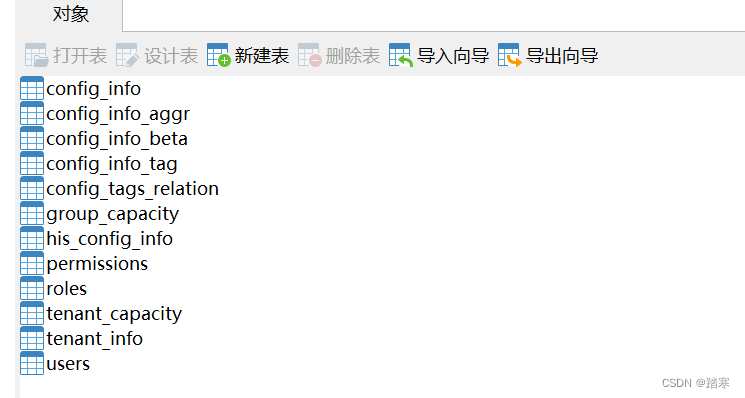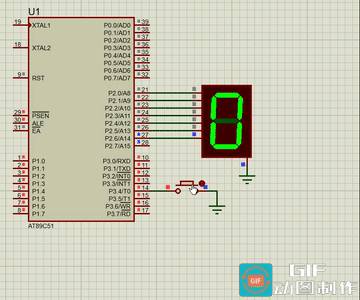一、Spring Boot
1.1 SpringBoot 构建方式
1.1.1 通过官网自动生成
进入官网:https://spring.io/,点击 Projects --> Spring Framework;

拖动滚动条到中间位置,点击 Spring Initializr 或者直接通过 https://start.spring.io/构建。
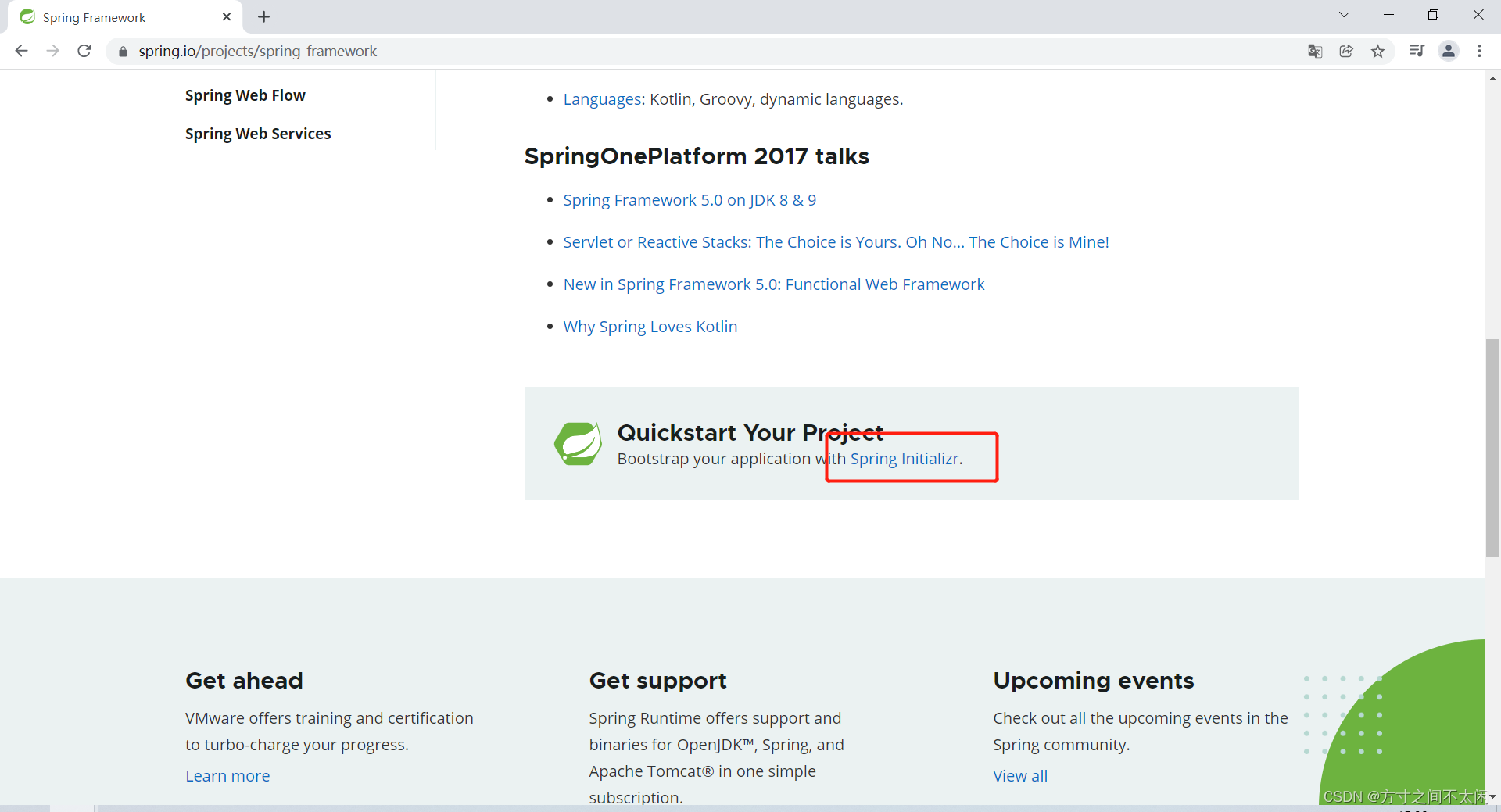
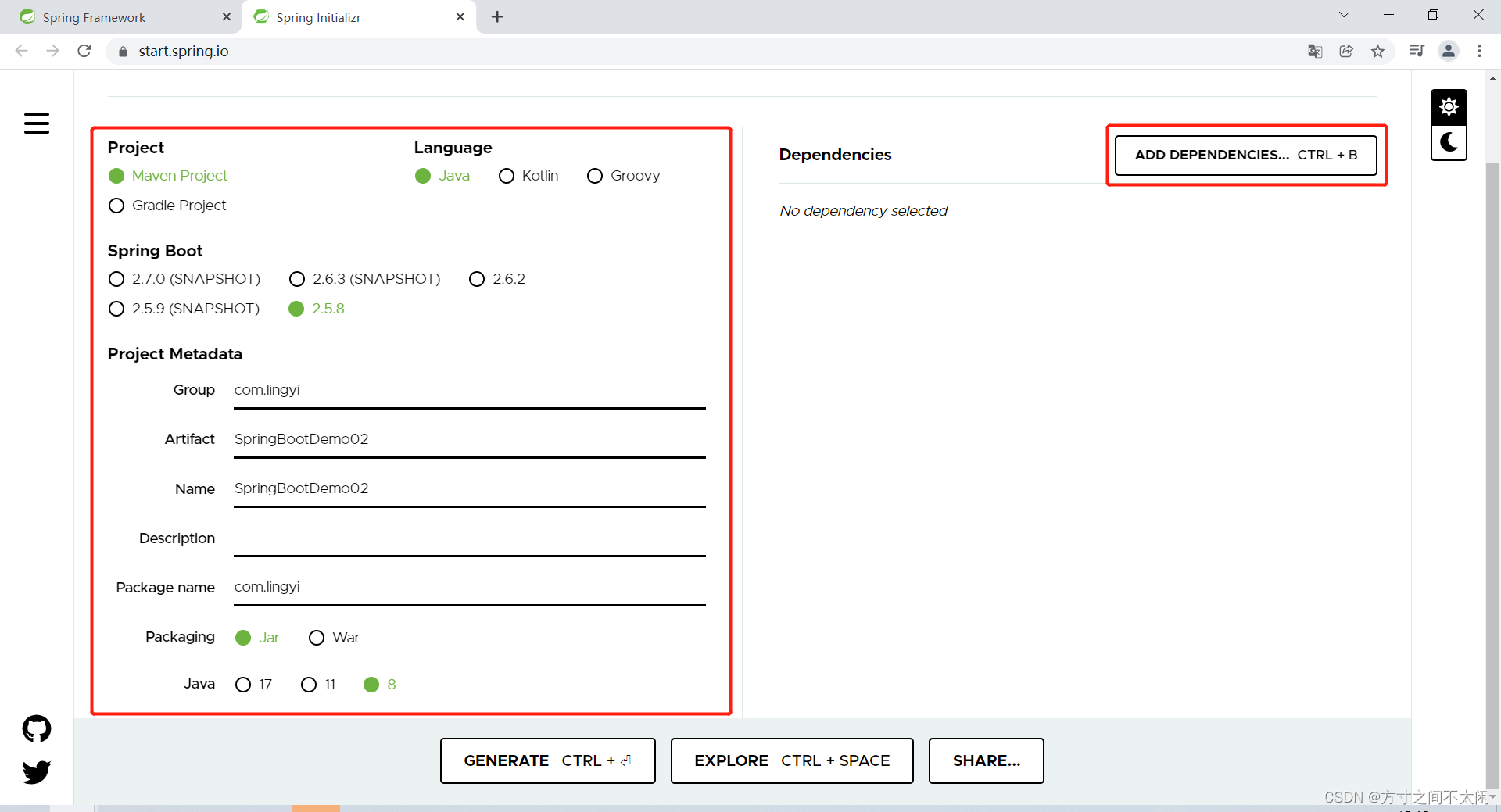
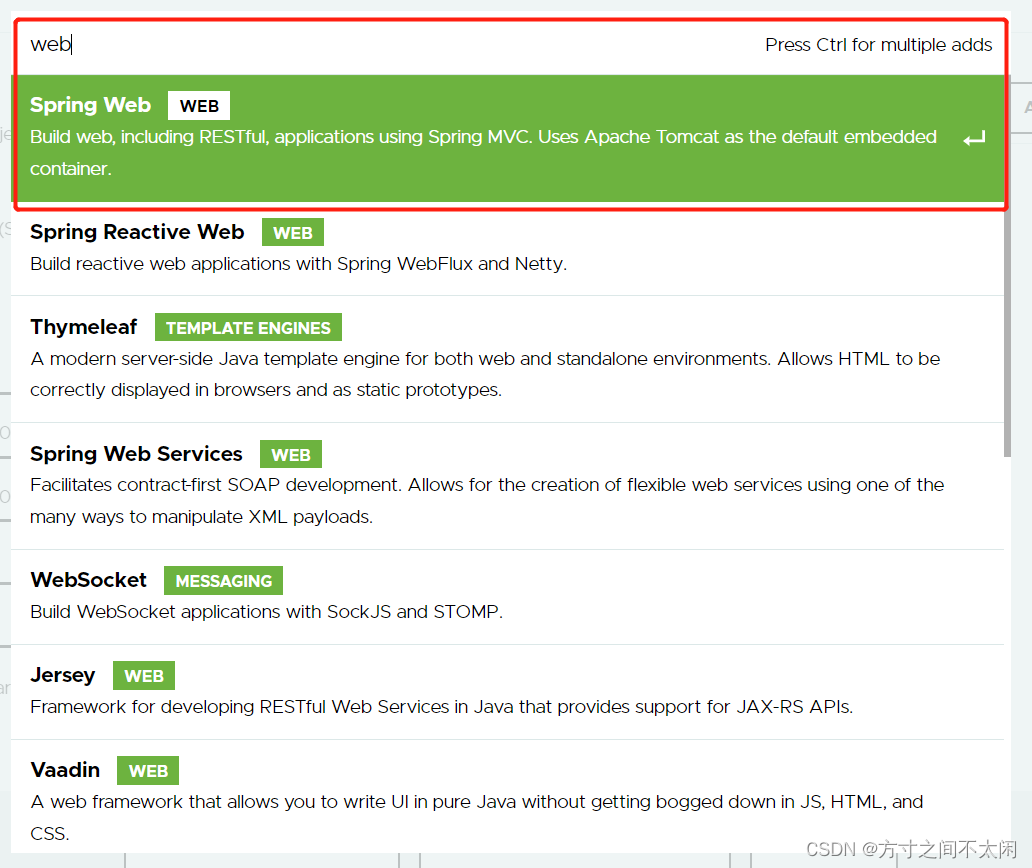
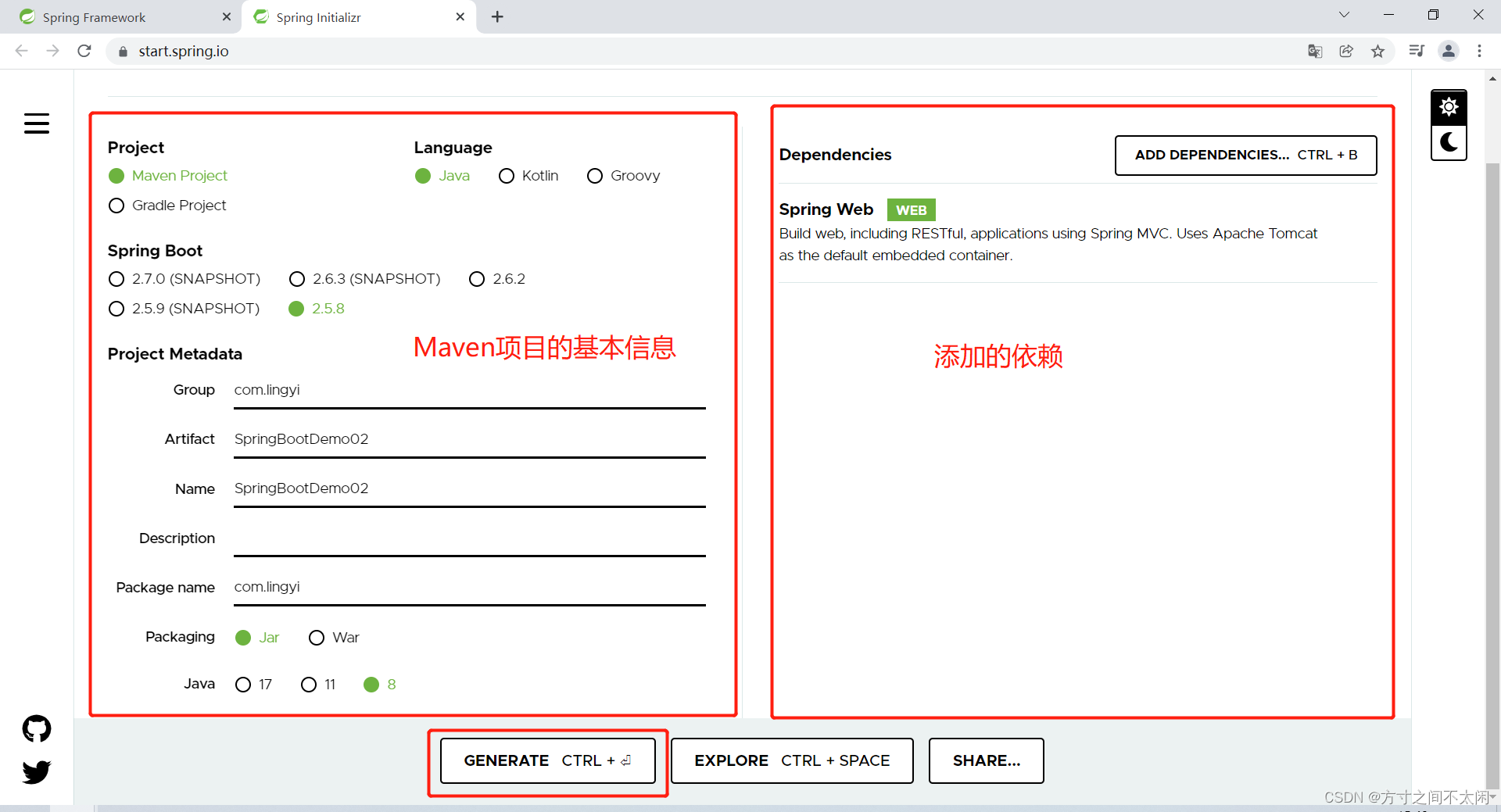
在线生成 SpringBoot 项目,然后解压直接导入。
1.1.2 IDE 在线模板生成
File --> New --> Project --> Spring Initializr

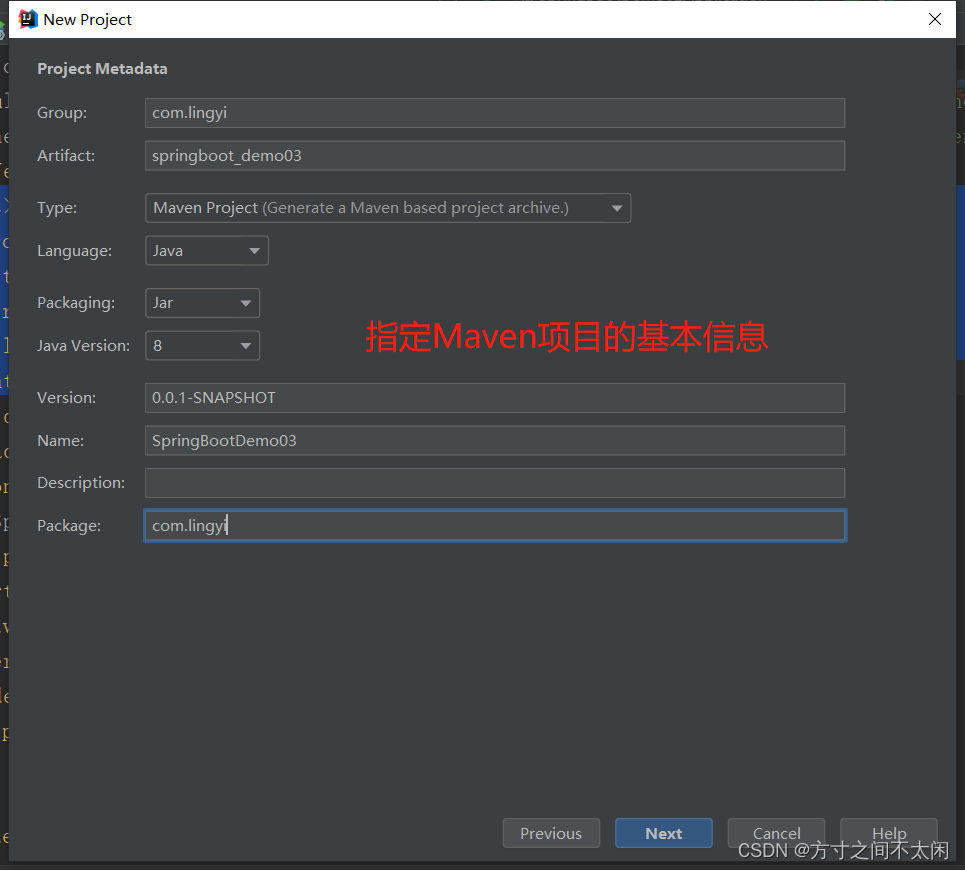
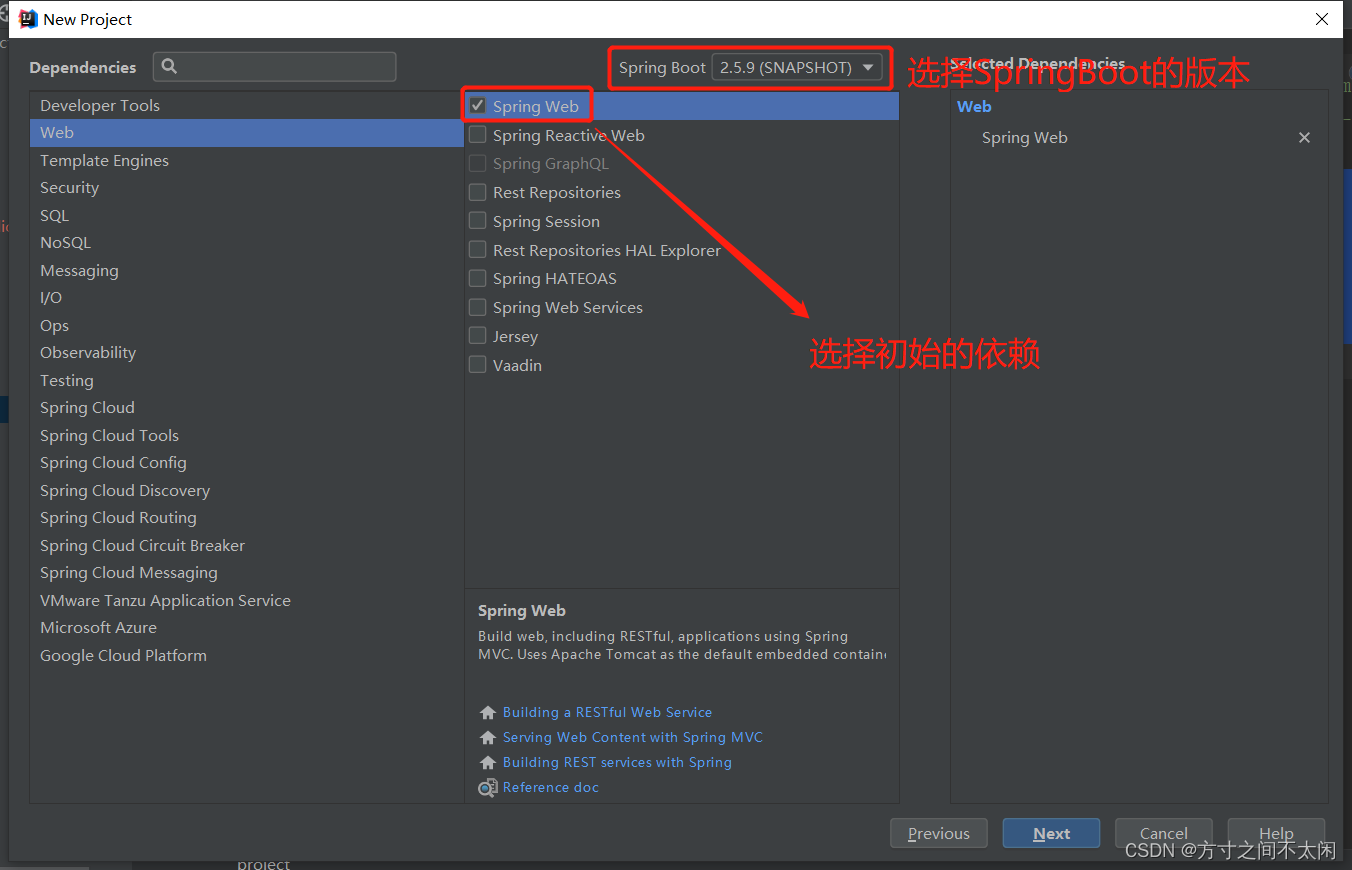
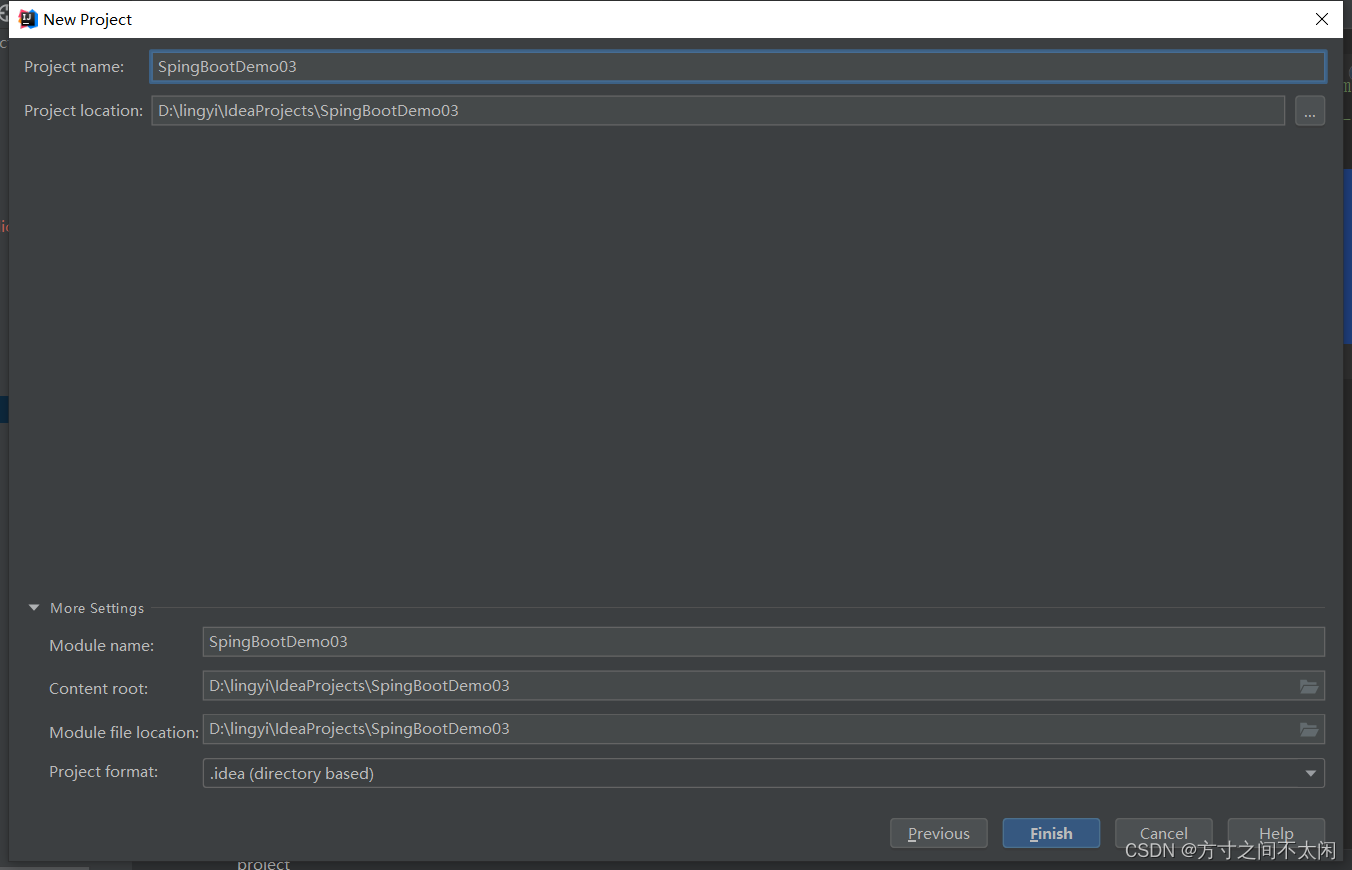
1.1.3 IDE 通过 Maven 项目构建
2.1.1 创建 Maven 项目

2.1.2 添加依赖
<!-- 1.添加SpringBoot的依赖 -->
<parent>
<artifactId>spring-boot-starter-parent</artifactId>
<groupId>org.springframework.boot</groupId>
<version>2.3.2.RELEASE</version>
</parent>
<dependencies>
<!-- 2.添加SpringMVC的支持 -->
<dependency>
<groupId>org.springframework.boot</groupId>
<artifactId>spring-boot-starter-web</artifactId>
</dependency>
</dependencies>
2.1.3 创建启动类
/**
* SpringBoot 项目的启动类
*/
@SpringBootApplication
public class AppStart {
public static void main(String[] args) {
SpringApplication.run(AppStart.class, args);
}
}
2.1.4 启动程序
执行主方法(main)即可。
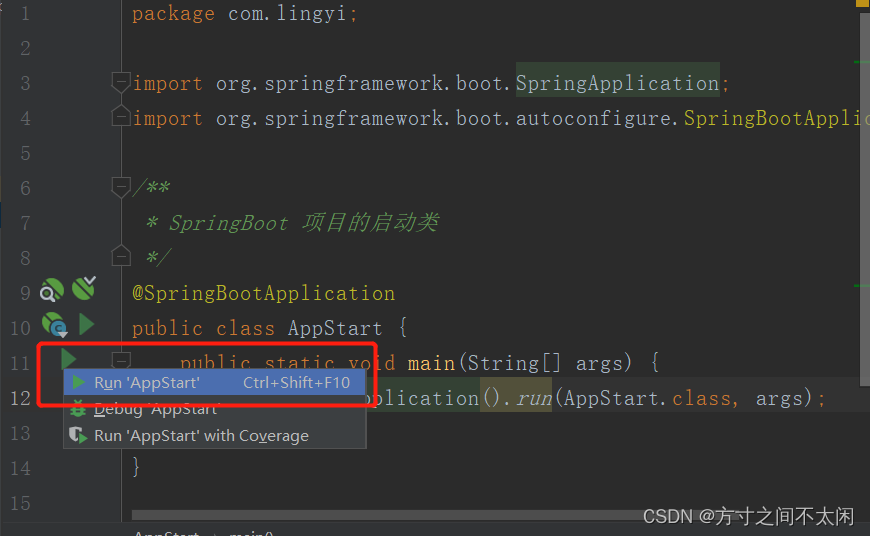

1.2 SpringBoot 中的常规配置
1.2.1 入口类和相关注解
@SpringBootApplication
public class SpringMybatisGenertorApplication {
public static void main(String[] args) {
SpringApplication.run(SpringMybatisGenertorApplication.class, args);
}
}@Target({ElementType.TYPE}) // 注解可以写在哪些地方
@Retention(RetentionPolicy.RUNTIME) // 该注解的作用域 RESOURCES CLASS RUNTIME
@Documented // 该注解会被API抽取
@Inherited // 可继承
// 以上四个是Java中提供的元注解
@SpringBootConfiguration // 本质上就是一个Configuration注解
@EnableAutoConfiguration // 自动装配的注解
@ComponentScan( // 扫描 会自动扫描 @SpringBootApplication所在的类的同级包(com.gupaoedu)以及子包中的Bean,所有一般我们建议将入口类放置在 groupId+artifcatID的组合包下
excludeFilters = {@Filter(
type = FilterType.CUSTOM,
classes = {TypeExcludeFilter.class}
), @Filter(
type = FilterType.CUSTOM,
classes = {AutoConfigurationExcludeFilter.class}
)}
)1.2.2 常规配置
- 默认属性
server.port=8082
server.servlet.context-path=/springboot
- 自定义属性
user.userName=admin
user.realName=零一
user.address=湖南长沙 @RestController
public class HelloController {
@Value(value = "${user.userName}")
private String userName;
@Value(value = "${user.realName}")
private String realName;
@Value(value = "${user.address}")
private String address;
@RequestMapping("/hello")
public String hello() {
System.out.println("Hello ..." + userName + " " + realName + " " + address);
return "Hello ...";
}
}
乱码问题:File --> Setting --> Editor --> File Encodings
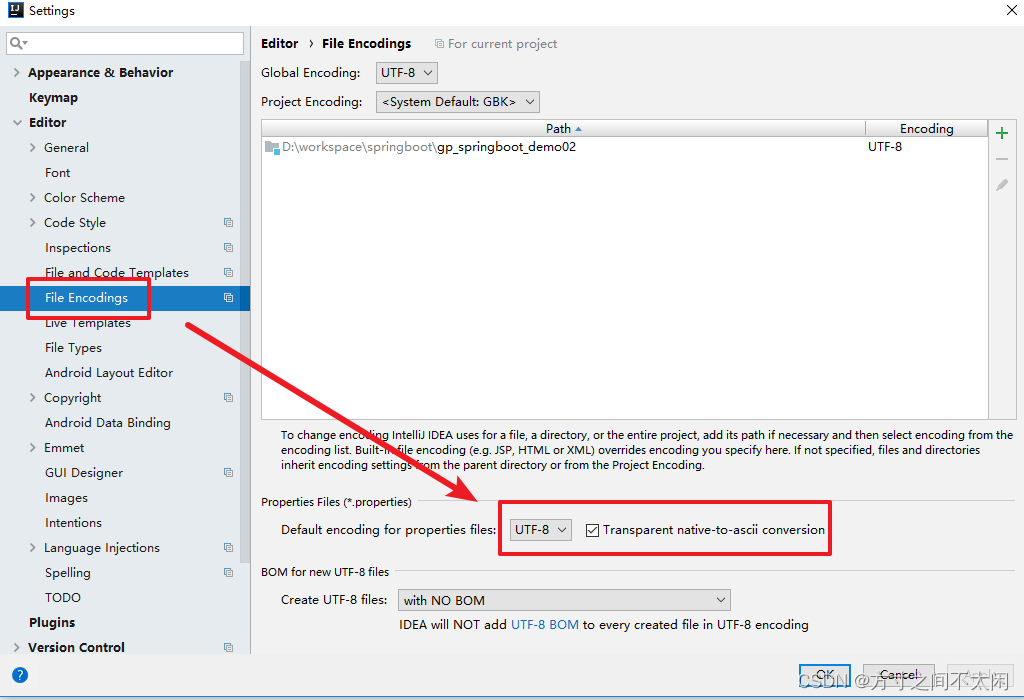
server.tomcat.uri-encoding=UTF-8
spring.http.encoding.charset=UTF-8
spring.http.encoding.enabled=true
spring.http.encoding.force=true
spring.messages.encoding=UTF-8
- 类型安全配置
<dependency>
<groupId>org.springframework.boot</groupId>
<artifactId>spring-boot-configuration-processor</artifactId>
<optional>true</optional>
</dependency> package com.gupaoedu.bean;
import org.springframework.boot.context.properties.ConfigurationProperties;
import org.springframework.stereotype.Component;
@Component
// 属性文件中的属性和User对象中的成员变量映射
@ConfigurationProperties(prefix = "user")
public class User {
private String username;
private Integer age;
private String address;
public String getUsername() {
return username;
}
public void setUsername(String username) {
this.username = username;
}
public Integer getAge() {
return age;
}
public void setAge(Integer age) {
this.age = age;
}
public String getAddress() {
return address;
}
public void setAddress(String address) {
this.address = address;
}
@Override
public String toString() {
return "User{" +
"username='" + username + '\'' +
", age=" + age +
", address='" + address + '\'' +
'}';
}
}
1.2.3 Logback 日志
# logback的配置
logging.file=d:/log.log
logging.level.org.springframework.web=DEBUG1.2.4 Profile
命名规则 application-xxx.properties
spring.profiles.active=xxx # 指定对应的环境
1.3 SpringBoot 中的静态资源
1.3.1 static 目录
SpringBoot 默认的存放静态资源的目录

1.3.2 webapp 目录
在 resources 同级目录下创建一个 webapp 目录,该目录的类型必须是 <u>ResourcesRoot</u>
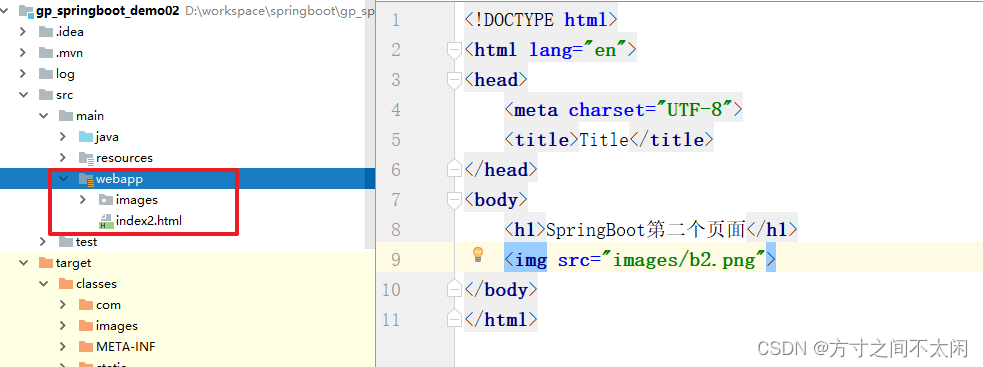
1.3.3 自定义静态资源路径
自定义目录后,创建对应的相关资源,然后在属性文件中去覆盖静态资源的路径配置即可。
# 表示所有的访问都经过静态资源路径
spring.webflux.static-path-pattern=/**
# 覆盖默认的配置,所有需要将默认的 static public 等这些路径将不能作为静态资源的访问
spring.resources.static-locations=classpath:/META-INF/resources/,clas
spath:/resources/,classpath:/static/,classpath:/custom
1.4 SpringBoot 自动装配
1.4.1 @EnableAutoConfiguration
@Target({ElementType.TYPE})
@Retention(RetentionPolicy.RUNTIME)
@Documented
@Inherited
@AutoConfigurationPackage
@Import({AutoConfigurationImportSelector.class})
public @interface EnableAutoConfiguration {
String ENABLED_OVERRIDE_PROPERTY = "spring.boot.enableautoconfiguration";
Class<?>[] exclude() default {};
String[] excludeName() default {};
}
通过@EnableAutoConfiguration 注解发现。其本身就是一个组合注解,有一个注解我们必须要弄清楚@Import 注解。
1.4.2 @Import
在 Spring 中我们将类型交给 SpringIoC 管理的方式有哪些?
> 1.基于xml配置文件<bean>
>
> 2.基于xml配置文件@Component
>
> 3.基于Java配置类【@Configuration】 @Bean
>
> 4.基于Java配置类+@ComponentScan+@Component
>
> 5.FactoryBean接口【getObject()】
>
> 6.@Import注解
第一种使用方式
静态使用方式
@Configuration
@Import(UserService.class)
public class JavaConfig {
/*@Bean
public UserService getUserSerivce(){
return new UserService();
}*/
}
在@Import 注解中直接指定要添加的类型。
缺点:直接在@Import 中写死要注入的类型,不太灵活。
第二种使用方式
ImportSelector 接口
public class GpImportSelector implements ImportSelector {
/**
* 动态获取IoC要加载的类型
* @param annotationMetadata 注解的元数据
* @return
* IoC要加载的类型的数组
*/
@Override
public String[] selectImports(AnnotationMetadata annotationMetadata) {
// 根据不同的业务逻辑 实现动态添加IoC加载的类型
/*if (){
}*/
return new String[]{LoggerService.class.getName(),CacheService.class.getName()};
}
}@Target({ElementType.TYPE})
@Retention(RetentionPolicy.RUNTIME)
@Documented
@Inherited
@Import(GpImportSelector.class)
public @interface EnableGpImport {
}
import org.springframework.context.ApplicationContext;
import org.springframework.context.annotation.AnnotationConfigApplicationContext;
@EnableGpImport
public class ImportMain {
public static void main(String[] args) {
ApplicationContext ac = new AnnotationConfigApplicationContext(ImportMain.class);
String[] beanDefinitionNames = ac.getBeanDefinitionNames();
for (String beanName : beanDefinitionNames){
System.out.println(beanName);
}
}
}
是将@Import 注解中添加的 ImportSelector 的实现类中的 selectImports 这个方法返回的字符串数组加载到 IoC 容器中。
第三种实现方式
实现 ImportBeanDefinitionRegistrar 接口,其实和第二种方式很类似,都是在源码设计层面用的比较多。
public class GpImportBeanDefinition implements ImportBeanDefinitionRegistrar {
/**
* 提供了一个beanDefinition的注册器,我直接把需要IoC加载的类型注册到容器中去
* @param annotationMetadata
* @param beanDefinitionRegistry beanDefinition的注册器
*/
@Override
public void registerBeanDefinitions(AnnotationMetadata annotationMetadata, BeanDefinitionRegistry beanDefinitionRegistry) {
// 将我们需要添加的类型统一封装为RootBeanDefinition对象
RootBeanDefinition cache = new RootBeanDefinition(CacheService.class);
beanDefinitionRegistry.registerBeanDefinition("cache",cache);
RootBeanDefinition logger = new RootBeanDefinition(LoggerService.class);
beanDefinitionRegistry.registerBeanDefinition("logger",logger);
}
}import org.springframework.context.ApplicationContext;
import org.springframework.context.annotation.AnnotationConfigApplicationContext;
@EnableGpImport
public class ImportMain {
public static void main(String[] args) {
ApplicationContext ac = new AnnotationConfigApplicationContext(ImportMain.class);
String[] beanDefinitionNames = ac.getBeanDefinitionNames();
for (String beanName : beanDefinitionNames){
System.out.println(beanName);
}
}
}1.4.3 自动装配的原理
1. 在 SpringBoot 项目启动的时候,会加载 SpringBootApplication 这个注解。
2. 会解析@EnableAutoConfiguration 注解。
3. 与之对应的解析@Import 注解。
4. 执行 ImportSelector 接口的的实现。
5. 加载 META-INF/spring-autoconfigure-metadata.properties 中的注解元数据信息。
6. 加载 META-INF/spring.factories 各种类路径【第三方扩展也同样的会加载对应的文件 SPI 扩展机制】。
1.5 SpringBoot 整合 Servlet
1.5.1 第一种方式
1. 添加自定义的 Servlet
package com.gupaoedu.servlet;
import javax.servlet.ServletException;
import javax.servlet.annotation.WebServlet;
import javax.servlet.http.HttpServlet;
import javax.servlet.http.HttpServletRequest;
import javax.servlet.http.HttpServletResponse;
import java.io.IOException;
import java.io.PrintWriter;
@WebServlet(name = "FirstServlet",urlPatterns = "/first")
public class FirstServlet extends HttpServlet {
@Override
protected void doGet(HttpServletRequest req, HttpServletResponse resp) throws ServletException, IOException {
System.out.println("FirstServlet running ... ");
PrintWriter out = resp.getWriter();
out.write("success ... ");
out.flush();
out.close();
}
}2. 在启动类中添加扫描注解
package com.gupaoedu;
import org.springframework.boot.SpringApplication;
import org.springframework.boot.autoconfigure.SpringBootApplication;
@SpringBootApplication
// 在SpringBoot启动的时候会扫描@WebServlet注解
@ServletComponentScan()
public class GpSpringbootDemo05Application {
public static void main(String[] args) {
SpringApplication.run(GpSpringbootDemo05Application.class, args);
}
}
1.5.2 第二种方式
1. 创建自定义的 Servlet,不需要添加@WebServlet
package com.gupaoedu.servlet;
import javax.servlet.ServletException;
import javax.servlet.http.HttpServlet;
import javax.servlet.http.HttpServletRequest;
import javax.servlet.http.HttpServletResponse;
import java.io.IOException;
import java.io.PrintWriter;
public class SecondServlet extends HttpServlet {
@Override
protected void doGet(HttpServletRequest req, HttpServletResponse resp) throws ServletException, IOException {
System.out.println("SecondServlet running ... ");
PrintWriter out = resp.getWriter();
out.write("success ... ");
out.flush();
out.close();
}
}2. 在启动类中显示在注册
package com.gupaoedu;
import com.gupaoedu.filter.SecondFilter;
import com.gupaoedu.listener.SecondListener;
import com.gupaoedu.servlet.SecondServlet;
import org.springframework.boot.SpringApplication;
import org.springframework.boot.autoconfigure.SpringBootApplication;
import org.springframework.boot.web.servlet.FilterRegistrationBean;
import org.springframework.boot.web.servlet.ServletComponentScan;
import org.springframework.boot.web.servlet.ServletListenerRegistrationBean;
import org.springframework.boot.web.servlet.ServletRegistrationBean;
import org.springframework.context.annotation.Bean;
@SpringBootApplication
// 在SpringBoot启动的时候会扫描@WebServlet注解
@ServletComponentScan()
public class GpSpringbootDemo05Application {
public static void main(String[] args) {
SpringApplication.run(GpSpringbootDemo05Application.class, args);
}
@Bean
public ServletRegistrationBean getRegistrationBean(){
// 将要添加的Servlet封装为一个ServletRegistrationBean对象
ServletRegistrationBean registrationBean = new ServletRegistrationBean(new SecondServlet());
// 设置映射信息
registrationBean.addUrlMappings("/second");
return registrationBean;
}
}1.6 SpringBoot 整合 Filter
1.6.1 第一种方式
1. 直接在过滤器中添加@WebFilter 注解
package com.gupaoedu.filter;
import javax.servlet.*;
import javax.servlet.annotation.WebFilter;
import java.io.IOException;
@WebFilter(urlPatterns = "/first")
public class FirstFilter implements Filter {
@Override
public void init(FilterConfig filterConfig) throws ServletException {
System.out.println("----init----");
}
@Override
public void doFilter(ServletRequest servletRequest, ServletResponse servletResponse, FilterChain filterChain) throws IOException, ServletException {
System.out.println("________First过滤器执行之前_________");
filterChain.doFilter(servletRequest,servletResponse);
System.out.println("________First过滤器执行之后_________");
}
@Override
public void destroy() {
System.out.println("****destroy****");
}
}2. 在启动器中添加@ServletCompoenentScan
package com.gupaoedu;
import com.gupaoedu.filter.SecondFilter;
import com.gupaoedu.listener.SecondListener;
import com.gupaoedu.servlet.SecondServlet;
import org.springframework.boot.SpringApplication;
import org.springframework.boot.autoconfigure.SpringBootApplication;
import org.springframework.boot.web.servlet.FilterRegistrationBean;
import org.springframework.boot.web.servlet.ServletComponentScan;
import org.springframework.boot.web.servlet.ServletListenerRegistrationBean;
import org.springframework.boot.web.servlet.ServletRegistrationBean;
import org.springframework.context.annotation.Bean;
@SpringBootApplication
// 在SpringBoot启动的时候会扫描@WebServlet注解
@ServletComponentScan()
public class GpSpringbootDemo05Application {
public static void main(String[] args) {
SpringApplication.run(GpSpringbootDemo05Application.class, args);
}
}1.6.2 第二种方式
1. 创建自定义的过滤器,不需要添加@WebFilter 注解。
package com.gupaoedu.filter;
import javax.servlet.*;
import java.io.IOException;
public class SecondFilter implements Filter {
@Override
public void init(FilterConfig filterConfig) throws ServletException {
System.out.println("--second--init----");
}
@Override
public void doFilter(ServletRequest servletRequest, ServletResponse servletResponse, FilterChain filterChain) throws IOException, ServletException {
System.out.println("________Second过滤器执行之前_________");
filterChain.doFilter(servletRequest,servletResponse);
System.out.println("________Second过滤器执行之后_________");
}
@Override
public void destroy() {
System.out.println("****destroy****");
}
}2. 在启动类中显示的注册
package com.gupaoedu;
import com.gupaoedu.filter.SecondFilter;
import com.gupaoedu.listener.SecondListener;
import com.gupaoedu.servlet.SecondServlet;
import org.springframework.boot.SpringApplication;
import org.springframework.boot.autoconfigure.SpringBootApplication;
import org.springframework.boot.web.servlet.FilterRegistrationBean;
import org.springframework.boot.web.servlet.ServletComponentScan;
import org.springframework.boot.web.servlet.ServletListenerRegistrationBean;
import org.springframework.boot.web.servlet.ServletRegistrationBean;
import org.springframework.context.annotation.Bean;
@SpringBootApplication
// 在SpringBoot启动的时候会扫描@WebServlet注解
@ServletComponentScan()
public class GpSpringbootDemo05Application {
public static void main(String[] args) {
SpringApplication.run(GpSpringbootDemo05Application.class, args);
}
@Bean
public FilterRegistrationBean getRegistractionBean(){
FilterRegistrationBean bean = new FilterRegistrationBean(new SecondFilter());
bean.addUrlPatterns("/second");
return bean;
}
}
1.7 SpringBoot 整合 Listener
1.7.1 第一种方式
1. 创建自定义的 Listener
package com.gupaoedu.listener;
import javax.servlet.ServletContextEvent;
import javax.servlet.ServletContextListener;
import javax.servlet.annotation.WebListener;
@WebListener
public class FirstListener implements ServletContextListener {
@Override
public void contextInitialized(ServletContextEvent sce) {
System.out.println("FirstListener : 初始化了....");
}
@Override
public void contextDestroyed(ServletContextEvent sce) {
System.out.println("FirstListener : 销毁了....");
}
}
2. 添加扫描注解
package com.gupaoedu;
import com.gupaoedu.filter.SecondFilter;
import com.gupaoedu.listener.SecondListener;
import com.gupaoedu.servlet.SecondServlet;
import org.springframework.boot.SpringApplication;
import org.springframework.boot.autoconfigure.SpringBootApplication;
import org.springframework.boot.web.servlet.FilterRegistrationBean;
import org.springframework.boot.web.servlet.ServletComponentScan;
import org.springframework.boot.web.servlet.ServletListenerRegistrationBean;
import org.springframework.boot.web.servlet.ServletRegistrationBean;
import org.springframework.context.annotation.Bean;
@SpringBootApplication
// 在SpringBoot启动的时候会扫描@WebServlet注解
@ServletComponentScan()
public class GpSpringbootDemo05Application {
public static void main(String[] args) {
SpringApplication.run(GpSpringbootDemo05Application.class, args);
}
}
1.7.2 第二种方式
1. 创建自定义 Listener
package com.gupaoedu.listener;
import javax.servlet.ServletContextEvent;
import javax.servlet.ServletContextListener;
public class SecondListener implements ServletContextListener {
@Override
public void contextInitialized(ServletContextEvent sce) {
System.out.println("SecondListener : 初始化了....");
}
@Override
public void contextDestroyed(ServletContextEvent sce) {
System.out.println("SecondListener : 销毁了....");
}
}
2. 显示的在启动类中注册
package com.gupaoedu;
import com.gupaoedu.filter.SecondFilter;
import com.gupaoedu.listener.SecondListener;
import com.gupaoedu.servlet.SecondServlet;
import org.springframework.boot.SpringApplication;
import org.springframework.boot.autoconfigure.SpringBootApplication;
import org.springframework.boot.web.servlet.FilterRegistrationBean;
import org.springframework.boot.web.servlet.ServletComponentScan;
import org.springframework.boot.web.servlet.ServletListenerRegistrationBean;
import org.springframework.boot.web.servlet.ServletRegistrationBean;
import org.springframework.context.annotation.Bean;
@SpringBootApplication
// 在SpringBoot启动的时候会扫描@WebServlet注解
@ServletComponentScan()
public class GpSpringbootDemo05Application {
public static void main(String[] args) {
SpringApplication.run(GpSpringbootDemo05Application.class, args);
}
@Bean
public ServletListenerRegistrationBean getListenerRegistrationBean(){
ServletListenerRegistrationBean bean = new ServletListenerRegistrationBean(new SecondListener());
return bean;
}
}1.8 SpringBoot 整合 Freemarker
1.8.1 添加对应的依赖
<dependency>
<groupId>org.springframework.boot</groupId>
<artifactId>spring-boot-starter-freemarker</artifactId>
</dependency>1.8.2 添加一个自定义的控制器
package com.gupaoedu.controller;
import com.gupaoedu.bean.User;
import org.springframework.stereotype.Controller;
import org.springframework.ui.Model;
import org.springframework.web.bind.annotation.RequestMapping;
import java.util.ArrayList;
import java.util.List;
@Controller
public class UserController {
@RequestMapping("/showUser")
public String showUser(Model model){
List<User> list = new ArrayList<>();
list.add(new User(1,"zhangsan",22));
list.add(new User(2,"lisi",23));
list.add(new User(3,"wangwu",24));
model.addAttribute("list",list);
return "user";
}
}1.8.3 属性文件配置
spring.freemarker.suffix=.ftl
1.8.4 ftl 模板页面
是一个 ftl 文件
<html>
<head>
<title>用户信息</title>
<meta charset="UTF-8">
</head>
<body>
<table border="1" align="center" width="50%">
<tr>
<th>ID</th>
<th>姓名</th>
<th>年龄</th>
</tr>
<#list list as user>
<tr>
<td>${user.id}</td>
<td>${user.userName}</td>
<td>${user.age}</td>
</tr>
</#list>
</table>
</body>
</html>
1.9 SpringBoot 整合 Thymeleaf
1.9.1 添加相关的依赖
<dependency>
<groupId>org.springframework.boot</groupId>
<artifactId>spring-boot-starter-thymeleaf</artifactId>
</dependency>1.9.2 创建自定义的控制器
package com.gupaoedu.controller;
import org.springframework.stereotype.Controller;
import org.springframework.ui.Model;
import org.springframework.web.bind.annotation.RequestMapping;
@Controller
public class UserController {
@RequestMapping("/show")
public String showInfo(Model model){
model.addAttribute("msg","Thymeleaf Hello ....");
return "index";
}
}1.9.3 创建对应的模板页面
Thymeleaf 的模板页面的后缀是`.html` 和我们讲的 html 页面的后缀是一样,但可以写标签。
<!DOCTYPE html>
<html lang="en" xmlns="http://www.w3.org/1999/xhtml" xmlns:th="http://www.thymeleaf.org">
<head>
<meta charset="UTF-8">
<title>Title</title>
</head>
<body>
<h1>Thymeleaf整合</h1>
<hr>
<span th:text="${msg}"></span>
</body>
</html>1.10 SpringBoot 实现热部署操作
1.10.1 打开配置


1.10.2 按下快捷键【ctrl+shift+alt+'/'】

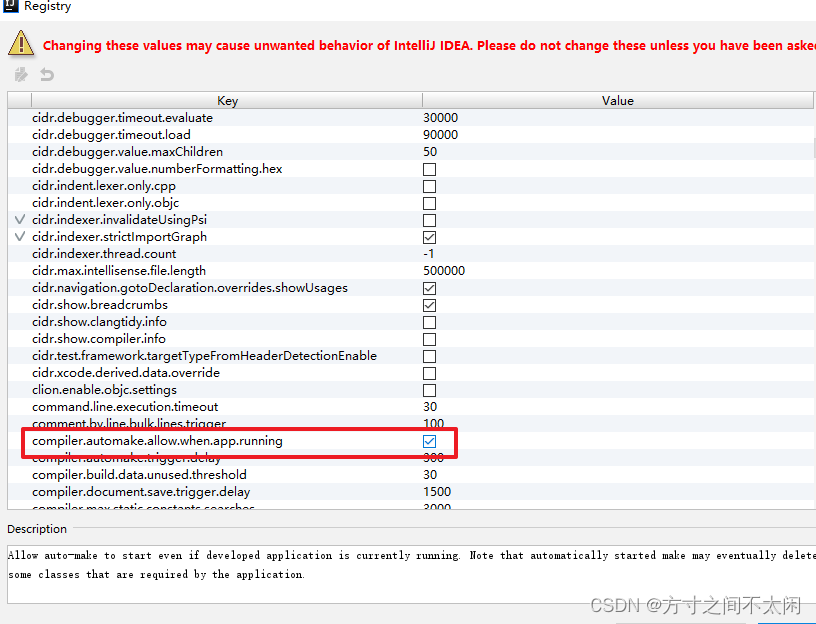
1.10.3 添加 spring-boot-devtools 依赖
<dependency>
<groupId>org.springframework.boot</groupId>
<artifactId>spring-boot-devtools</artifactId>
</dependency>
<build>
<plugins>
<plugin>
<groupId>org.springframework.boot</groupId>
<artifactId>spring-boot-maven-plugin</artifactId>
<configuration>
<fork>true</fork>
</configuration>
</plugin>
</plugins>
</build>1.11 SpringBoot 中的异常处理
1.11.1 自定义错误页面
SpringBoot 默认的处理异常的机制:SpringBoot 默认的已经提供了一套处理异常的机制。一旦程序中出现了异常 SpringBoot 会像/error 的 url 发送请求。在 springBoot 中提供了一个叫 BasicExceptionController 来处理/error 请求,然后跳转到默认显示异常的页面来展示异常信息。

我们只需要在 resources/templates 中添加一个 error.html 页面即可。

1.11.2 @ExceptionHandler 处理
针对特定的异常处理。
控制器:
package com.gupaoedu.controller;
import org.springframework.stereotype.Controller;
import org.springframework.ui.Model;
import org.springframework.web.bind.annotation.ExceptionHandler;
import org.springframework.web.bind.annotation.RequestMapping;
import org.springframework.web.servlet.ModelAndView;
import javax.validation.constraints.Null;
@Controller
public class UserController {
@RequestMapping("/show1")
public String showInfo1(){
String msg = null;
msg.length(); // NullPointerException
return "success";
}
/**
* 如果当前类中出现了NullPointerException异常就会跳转到本方法对应的view中
* @return
*/
@ExceptionHandler(value = {NullPointerException.class})
public ModelAndView nullPointerExceptionHandler(Exception e){
ModelAndView view = new ModelAndView();
view.addObject("error",e.toString());
view.setViewName("error1");
return view;
}
/**
* 如果当前类中出现了ArithmeticException异常就会跳转到本方法对应的view中
* @return
*/
@ExceptionHandler(value = {ArithmeticException.class})
public ModelAndView arithmeticExceptionHandler(Exception e){
ModelAndView view = new ModelAndView();
view.addObject("error",e.toString());
view.setViewName("error2");
return view;
}
@RequestMapping("/show2")
public String showInfo2(){
int i = 0;
int b = 100;
System.out.println(b/i); // ArithmeicExpetion
return "success";
}
}
异常处理代码和业务代码耦合性比较强。
1.11.3 @ControllerAdvice 处理
实现业务代码和系统异常处理代码解耦。
package com.gupaoedu.handler;
import org.springframework.web.bind.annotation.ControllerAdvice;
import org.springframework.web.bind.annotation.ExceptionHandler;
import org.springframework.web.servlet.ModelAndView;
@ControllerAdvice
public class GlobalException {
/**
* 如果当前类中出现了NullPointerException异常就会跳转到本方法对应的view中
* @return
*/
@ExceptionHandler(value = {NullPointerException.class})
public ModelAndView nullPointerExceptionHandler(Exception e){
ModelAndView view = new ModelAndView();
view.addObject("error",e.toString());
view.setViewName("error1");
return view;
}
/**
* 如果当前类中出现了ArithmeticException异常就会跳转到本方法对应的view中
* @return
*/
@ExceptionHandler(value = {ArithmeticException.class})
public ModelAndView arithmeticExceptionHandler(Exception e){
ModelAndView view = new ModelAndView();
view.addObject("error",e.toString());
view.setViewName("error2");
return view;
}
}
1.11.4 SimpleMappingExceptionResolver 处理
通过系统提供的异常映射处理实现
package com.gupaoedu;
import org.springframework.boot.SpringApplication;
import org.springframework.boot.autoconfigure.SpringBootApplication;
import org.springframework.context.annotation.Bean;
import org.springframework.web.servlet.handler.SimpleMappingExceptionResolver;
import java.util.Properties;
@SpringBootApplication
public class GpSpringbootDemo08ThymeleafApplication {
public static void main(String[] args) {
SpringApplication.run(GpSpringbootDemo08ThymeleafApplication.class, args);
}
/**
* 异常信息和对应的 处理地址的 映射
* @return
*/
@Bean
public SimpleMappingExceptionResolver getSimpleMappingExceptionResolver(){
SimpleMappingExceptionResolver mapping = new SimpleMappingExceptionResolver();
Properties mappings = new Properties();
mappings.setProperty("java.lang.NullPointerException","error1");
mappings.setProperty("java.lang.ArithmeticException","error2");
mapping.setExceptionMappings(mappings);
return mapping;
}
}1.11.5 自定义 HandlerExceptionResolver
package com.gupaoedu.handler;
import org.springframework.stereotype.Component;
import org.springframework.web.servlet.HandlerExceptionResolver;
import org.springframework.web.servlet.ModelAndView;
import javax.servlet.http.HttpServletRequest;
import javax.servlet.http.HttpServletResponse;
@Component
public class MyHandlerExceptionResolver implements HandlerExceptionResolver {
/**
* 自定义的全局异常
* @param httpServletRequest
* @param httpServletResponse
* @param o
* @param e
* @return
*/
@Override
public ModelAndView resolveException(HttpServletRequest httpServletRequest
, HttpServletResponse httpServletResponse
, Object o, Exception e) {
System.out.println("全局的自定义异常处理触发了....");
ModelAndView mv = new ModelAndView();
if(e instanceof NullPointerException){
mv.setViewName("error1");
mv.addObject("error","空指针异常");
}else if(e instanceof ArithmeticException){
mv.setViewName("error2");
mv.addObject("error","算数异常");
}
return mv;
}
}1.12 SpringBoot 中的单元测试
1.12.1 添加依赖
<dependency>
<groupId>org.springframework.boot</groupId>
<artifactId>spring-boot-starter-test</artifactId>
<scope>test</scope>
</dependency>1.12.2 单元测试
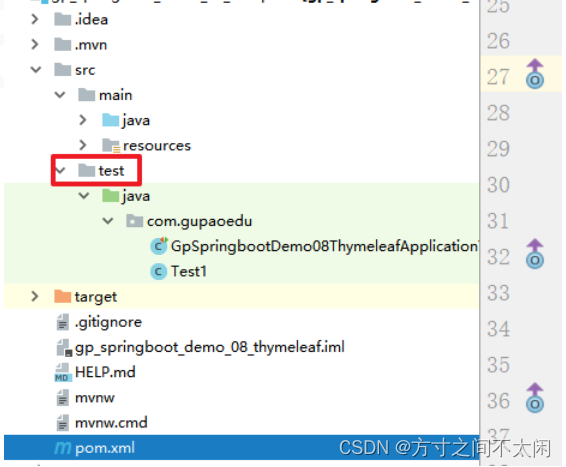
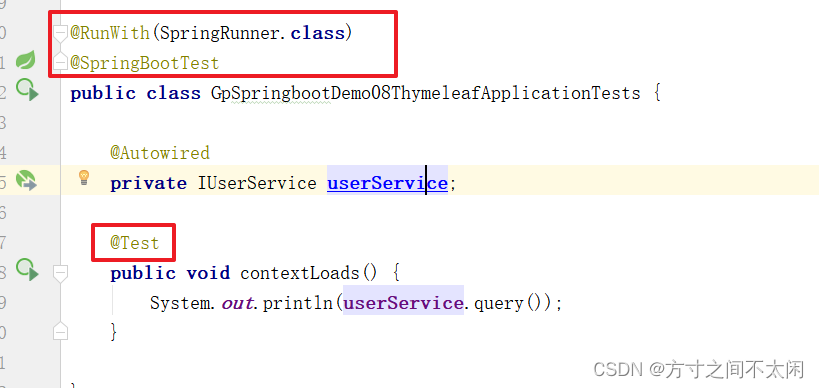
1.13 SpringBoot 整合 MyBatis
整合 MyBatis 同时结合 SpringMVC+Thymeleaf 完成 CRUD 操作。
1.13.1 添加依赖
<?xml version="1.0" encoding="UTF-8"?>
<project xmlns="http://maven.apache.org/POM/4.0.0"
xmlns:xsi="http://www.w3.org/2001/XMLSchema-instance"
xsi:schemaLocation="http://maven.apache.org/POM/4.0.0 http://maven.apache.org/xsd/maven-4.0.0.xsd">
<modelVersion>4.0.0</modelVersion>
<groupId>com.gupaoedu</groupId>
<artifactId>gp_springboot_mybatis_demo</artifactId>
<version>1.0-SNAPSHOT</version>
<!-- 配置依赖的父类 -->
<parent>
<groupId>org.springframework.boot</groupId>
<artifactId>spring-boot-starter-parent</artifactId>
<version>2.1.5.RELEASE</version>
</parent>
<dependencies>
<dependency>
<groupId>org.springframework.boot</groupId>
<artifactId>spring-boot-starter-web</artifactId>
</dependency>
<dependency>
<groupId>org.springframework.boot</groupId>
<artifactId>spring-boot-starter-thymeleaf</artifactId>
</dependency>
<dependency>
<groupId>org.mybatis.spring.boot</groupId>
<artifactId>mybatis-spring-boot-starter</artifactId>
<version>1.3.2</version>
</dependency>
<dependency>
<groupId>mysql</groupId>
<artifactId>mysql-connector-java</artifactId>
</dependency>
<dependency>
<groupId>com.alibaba</groupId>
<artifactId>druid</artifactId>
<version>1.0.14</version>
</dependency>
</dependencies>
</project>1.13.2 配置文件
# jdbc的相关配置
spring.datasource.driver-class-name=com.mysql.jdbc.Driver
spring.datasource.url=jdbc:mysql://localhost:3306/test?serverTimezone=UTC
spring.datasource.username=root
spring.datasource.password=123456
# 连接池
spring.datasource.type=com.alibaba.druid.pool.DruidDataSource
## mybatis的package别名
mybatis.type-aliases-package=com.gupaoedu.pojo
# 指定MyBatis的映射文件的路径
mybatis.mapper-locations=classpath:mapper/*.xml1.13.3 启动器
package com.gupaoedu;
import org.springframework.boot.SpringApplication;
import org.springframework.boot.autoconfigure.SpringBootApplication;
@SpringBootApplication
public class StartApp {
public static void main(String[] args) {
SpringApplication.run(StartApp.class,args);
}
}1.13.4 数据库表结构
CREATE TABLE `users` (
`id` int(11) NOT NULL AUTO_INCREMENT,
`name` varchar(255) DEFAULT NULL,
`age` int(11) DEFAULT NULL, PRIMARY KEY (`id`)
) ENGINE=InnoDB DEFAULT CHARSET=utf8;1.13.5 创建对应的 Pojo 对象
package com.gupaoedu.pojo;
public class User {
private Integer id;
private String name;
private Integer age;
public Integer getId() {
return id;
}
public void setId(Integer id) {
this.id = id;
}
public String getName() {
return name;
}
public void setName(String name) {
this.name = name;
}
public Integer getAge() {
return age;
}
public void setAge(Integer age) {
this.age = age;
}
@Override
public String toString() {
return "User{" +
"id=" + id +
", name='" + name + '\'' +
", age=" + age +
'}';
}
}
1.13.6 mapper 接口
package com.gupaoedu.mapper;
import com.gupaoedu.pojo.User;
import java.util.List;
public interface UserMapper {
public List<User> query(User user);
public Integer addUser(User user);
/**
* 根据id查询用户信息
* @param id
* @return
*/
public User queryById(Integer id);
public Integer deleteUserById(Integer id);
public Integer updateUser(User user);
}1.13.7 mapper 映射文件
文件地址:src/main/resources/mapper/UserMapper.xml
<?xml version="1.0" encoding="UTF-8" ?>
<!DOCTYPE mapper
PUBLIC "-//mybatis.org//DTD Mapper 3.0//EN"
"http://mybatis.org/dtd/mybatis-3-mapper.dtd">
<mapper namespace="com.gupaoedu.mapper.UserMapper">
<select id="query" resultType="User">
select * from users
</select>
<insert id="addUser" parameterType="User">
INSERT INTO users (name,age)VALUES(#{name},#{age})
</insert>
<select id="queryById" resultType="User" >
select * from users where id = #{id}
</select>
<update id="updateUser" parameterType="User">
update users set name=#{name},age=#{age} where id =#{id}
</update>
<delete id="deleteUserById" >
delete from users where id = #{id}
</delete>
</mapper>1.13.8 Service 接口
package com.gupaoedu.service;
import com.gupaoedu.pojo.User;
import java.util.List;
public interface IUserService {
public List<User> query(User user);
public Integer addUser(User user);
/**
* 根据id查询用户信息
* @param id
* @return
*/
public User queryById(Integer id);
public Integer updateUser(User user);
public Integer deleteUserById(Integer id);
}1.13.9 Service 实现类
package com.gupaoedu.service.impl;
import com.gupaoedu.mapper.UserMapper;
import com.gupaoedu.pojo.User;
import com.gupaoedu.service.IUserService;
import org.springframework.beans.factory.annotation.Autowired;
import org.springframework.stereotype.Service;
import org.springframework.transaction.annotation.Transactional;
import java.util.List;
@Service
@Transactional
public class UserServiceImpl implements IUserService {
@Autowired
private UserMapper mapper;
@Override
public List<User> query(User user) {
return mapper.query(user);
}
@Override
public Integer addUser(User user) {
return mapper.addUser(user);
}
@Override
public User queryById(Integer id) {
return mapper.queryById(id);
}
@Override
public Integer updateUser(User user) {
return mapper.updateUser(user);
}
@Override
public Integer deleteUserById(Integer id) {
return mapper.deleteUserById(id);
}
}1.13.10 controller
package com.gupaoedu.controller;
import com.gupaoedu.pojo.User;
import com.gupaoedu.service.IUserService;
import org.springframework.beans.factory.annotation.Autowired;
import org.springframework.stereotype.Controller;
import org.springframework.ui.Model;
import org.springframework.web.bind.annotation.PathVariable;
import org.springframework.web.bind.annotation.RequestMapping;
import org.springframework.web.bind.annotation.RestController;
import java.util.List;
@Controller
public class UserController {
@Autowired
private IUserService service;
/**
* 基础页面的请求
* @param page
* @return
*/
@RequestMapping("/{page}")
public String showPage(@PathVariable String page){
return page;
}
@RequestMapping("/user/query")
public String query(Model model){
model.addAttribute("list",service.query(null));
return "user";
}
@RequestMapping("/user/save")
public String addUser(User user){
service.addUser(user);
return "redirect:/user/query";
}
@RequestMapping("/user/updateInfo")
public String updateInfo(Integer id,Model model){
User user = service.queryById(id);
model.addAttribute("user",user);
return "updateUser";
}
@RequestMapping("/user/deleteUser")
public String deleteUser(Integer id){
service.deleteUserById(id);
return "redirect:/user/query";
}
@RequestMapping("/user/update")
public String updateUser(User user){
service.updateUser(user);
return "redirect:/user/query";
}
}
1.13.11 启动类添加 Mapper 扫描路径
package com.gupaoedu;
import org.mybatis.spring.annotation.MapperScan;
import org.springframework.boot.SpringApplication;
import org.springframework.boot.autoconfigure.SpringBootApplication;
@SpringBootApplication
@MapperScan("com.gupaoedu.mapper") // 用户扫描Mapper接口
public class StartApp {
public static void main(String[] args) {
SpringApplication.run(StartApp.class,args);
}
}1.13.12 用户信息查询
控制器
@Controller
public class UserController {
@Autowired
private IUserService service;
@RequestMapping("/user/query")
public String query(Model model){
model.addAttribute("list",service.query(null));
return "user";
}
}
模板页面(src\main\resources\templates\user.html)
<!DOCTYPE html>
<html lang="en" xmlns="http://www.w3.org/1999/xhtml" xmlns:th="http://www.thymeleaf.org">
<head>
<meta charset="UTF-8">
<title>用户信息</title>
</head>
<body>
<h1>用户管理</h1>
<table border="1" style="width: 300px">
<tr>
<th>用户ID</th>
<th>用户姓名</th>
<th>用户年龄</th>
</tr>
<tr th:each="user:${list}">
<td th:text="${user.id}"></td>
<td th:text="${user.name}"></td>
<td th:text="${user.age}"></td>
</tr>
</table>
</body>
</html>1.13.13 用户信息添加
mapper 接口
public interface UserMapper {
public List<User> query(User user);
public Integer addUser(User user);
}
mapper 映射文件
<insert id="addUser" parameterType="User">
INSERT INTO users (name,age)VALUES(#{name},#{age})
</insert>
service接口
public interface IUserService {
public List<User> query(User user);
public Integer addUser(User user);
}
service 实现类
@Service
@Transactional
public class UserServiceImpl implements IUserService {
@Autowired
private UserMapper mapper;
@Override
public List<User> query(User user) {
return mapper.query(user);
}
@Override
public Integer addUser(User user) {
return mapper.addUser(user);
}
}
控制器
@Controller
public class UserController {
@Autowired
private IUserService service;
@RequestMapping("/user/query")
public String query(Model model){
model.addAttribute("list",service.query(null));
return "user";
}
@RequestMapping("/user/save")
public String addUser(User user){
service.addUser(user);
return "redirect:/user/query";
}
}
页面(src\main\resources\templates\addUser.html)
<!DOCTYPE html>
<html lang="en" xmlns="http://www.w3.org/1999/xhtml" xmlns:th="http://www.thymeleaf.org">
<head>
<meta charset="UTF-8">
<title>用户信息</title>
</head>
<body>
<h1>添加用户</h1>
<form th:action="@{/user/save}" method="post">
<label>姓名:</label><input type="text" name="name"><br>
<label>年龄:</label><input type="text" name="age"><br>
<input type="submit" value="提交">
</form>
</body>
</html>
基础跳转请求
/**
* 基础页面的请求
* @param page
* @return
*/
@RequestMapping("/{page}")
public String showPage(@PathVariable String page){
return page;
}
1.13.14 用户信息修改
页面添加修改按钮(src\main\resources\templates\user.html)
<!DOCTYPE html>
<html lang="en" xmlns="http://www.w3.org/1999/xhtml" xmlns:th="http://www.thymeleaf.org">
<head>
<meta charset="UTF-8">
<title>用户信息</title>
</head>
<body>
<h1>用户管理</h1>
<table border="1" style="width: 300px">
<tr>
<th>用户ID</th>
<th>用户姓名</th>
<th>用户年龄</th>
<th>操作</th>
</tr>
<tr th:each="user:${list}">
<td th:text="${user.id}"></td>
<td th:text="${user.name}"></td>
<td th:text="${user.age}"></td>
<td>
<a th:href="@{/user/updateInfo(id=${user.id})}">修改</a>
</td>
</tr>
</table>
</body>
</html>
mapper 接口
package com.gupaoedu.mapper;
import com.gupaoedu.pojo.User;
import java.util.List;
public interface UserMapper {
public List<User> query(User user);
public Integer addUser(User user);
/**
* 根据id查询用户信息
* @param id
* @return
*/
public User queryById(Integer id);
public Integer updateUser(User user);
}
mapper 映射文件
<?xml version="1.0" encoding="UTF-8" ?>
<!DOCTYPE mapper
PUBLIC "-//mybatis.org//DTD Mapper 3.0//EN"
"http://mybatis.org/dtd/mybatis-3-mapper.dtd">
<mapper namespace="com.gupaoedu.mapper.UserMapper">
<select id="query" resultType="User">
select * from users
</select>
<insert id="addUser" parameterType="User">
INSERT INTO users (name,age)VALUES(#{name},#{age})
</insert>
<select id="queryById" resultType="User" >
select * from users where id = #{id}
</select>
<update id="updateUser" parameterType="User">
update users set name=#{name},age=#{age} where id =#{id}
</update>
</mapper>
控制器
package com.gupaoedu.controller;
import com.gupaoedu.pojo.User;
import com.gupaoedu.service.IUserService;
import org.springframework.beans.factory.annotation.Autowired;
import org.springframework.stereotype.Controller;
import org.springframework.ui.Model;
import org.springframework.web.bind.annotation.PathVariable;
import org.springframework.web.bind.annotation.RequestMapping;
import org.springframework.web.bind.annotation.RestController;
import java.util.List;
@Controller
public class UserController {
@Autowired
private IUserService service;
/**
* 基础页面的请求
* @param page
* @return
*/
@RequestMapping("/{page}")
public String showPage(@PathVariable String page){
return page;
}
@RequestMapping("/user/query")
public String query(Model model){
model.addAttribute("list",service.query(null));
return "user";
}
@RequestMapping("/user/save")
public String addUser(User user){
service.addUser(user);
return "redirect:/user/query";
}
@RequestMapping("/user/updateInfo")
public String updateInfo(Integer id,Model model){
User user = service.queryById(id);
model.addAttribute("user",user);
return "updateUser";
}
@RequestMapping("/user/update")
public String updateUser(User user){
service.updateUser(user);
return "redirect:/user/query";
}
}
跳转到修改界面(src\main\resources\templates\addUser.html)
<!DOCTYPE html>
<html lang="en" xmlns="http://www.w3.org/1999/xhtml" xmlns:th="http://www.thymeleaf.org">
<head>
<meta charset="UTF-8">
<title>用户信息</title>
</head>
<body>
<h1>更新用户</h1>
<form th:action="@{/user/update}" method="post">
<input type="hidden" name="id" th:value="${user.id}">
<label>姓名:</label><input type="text" name="name" th:value="${user.name}"><br>
<label>年龄:</label><input type="text" name="age" th:value="${user.age}"><br>
<input type="submit" value="提交">
</form>
</body>
</html>1.13. 15 用户信息删除
添加删除按钮(src\main\resources\templates\user.html)
<!DOCTYPE html>
<html lang="en" xmlns="http://www.w3.org/1999/xhtml" xmlns:th="http://www.thymeleaf.org">
<head>
<meta charset="UTF-8">
<title>用户信息</title>
</head>
<body>
<h1>用户管理</h1>
<table border="1" style="width: 300px">
<tr>
<th>用户ID</th>
<th>用户姓名</th>
<th>用户年龄</th>
<th>操作</th>
</tr>
<tr th:each="user:${list}">
<td th:text="${user.id}"></td>
<td th:text="${user.name}"></td>
<td th:text="${user.age}"></td>
<td>
<a th:href="@{/user/updateInfo(id=${user.id})}">修改</a>
<a th:href="@{/user/deleteUser(id=${user.id})}">删除</a>
</td>
</tr>
</table>
</body>
</html>
控制器:提交删除的编号
@RequestMapping("/user/deleteUser")
public String deleteUser(Integer id){
service.deleteUserById(id);
return "redirect:/user/query";
}
1.14 SpringBoot 整合 Shiro
1.14.1 表结构
CREATE TABLE `t_user` (
`id` int(20) NOT NULL AUTO_INCREMENT,
`username` varchar(20) DEFAULT NULL,
`password` varchar(100) DEFAULT NULL,
`salt` varchar(100) DEFAULT NULL,
`create_time` datetime DEFAULT NULL,
`state` int(1) DEFAULT NULL,
`last_login_time` datetime DEFAULT NULL,
`nickname` varchar(30) DEFAULT NULL,
`realname` varchar(255) DEFAULT NULL,
PRIMARY KEY (`id`)
) ENGINE=InnoDB AUTO_INCREMENT=7 DEFAULT CHARSET=utf8;
1.14.2 添加依赖
<dependency>
<groupId>org.apache.shiro</groupId>
<artifactId>shiro-spring</artifactId>
<version>1.3.2</version>
</dependency>1.14.3 自定义的 realm
package com.gupaoedu.realm;
import org.apache.shiro.authc.AuthenticationException;
import org.apache.shiro.authc.AuthenticationInfo;
import org.apache.shiro.authc.AuthenticationToken;
import org.apache.shiro.authz.AuthorizationInfo;
import org.apache.shiro.realm.AuthorizingRealm;
import org.apache.shiro.subject.PrincipalCollection;
public class AuthcRealm extends AuthorizingRealm {
/**
* 认证的方法
* @param authenticationToken
* @return
* @throws AuthenticationException
*/
@Override
protected AuthenticationInfo doGetAuthenticationInfo(AuthenticationToken authenticationToken) throws AuthenticationException {
return null;
}
/**
* 授权的方法
* @param principalCollection
* @return
*/
@Override
protected AuthorizationInfo doGetAuthorizationInfo(PrincipalCollection principalCollection) {
return null;
}
}
1.14.4 Shiro 的配置类
将我们原来写在 xml 文件中的配置添加到了 Java 类中。
package com.gupaoedu.config;
import com.gupaoedu.realm.AuthcRealm;
import org.apache.shiro.authc.credential.HashedCredentialsMatcher;
import org.apache.shiro.mgt.SecurityManager;
import org.apache.shiro.spring.web.ShiroFilterFactoryBean;
import org.apache.shiro.web.mgt.DefaultWebSecurityManager;
import org.springframework.context.annotation.Bean;
import org.springframework.context.annotation.Configuration;
import org.springframework.context.annotation.DependsOn;
import java.util.HashMap;
import java.util.Map;
@Configuration
public class ShiroConfig {
// 散列算法
private String hashAlgorithmName = "md5";
// 迭代次数
private Integer hashIterations = 1024;
/**
* 获取凭证匹配器
* @return
*/
@Bean
public HashedCredentialsMatcher hashedCredentialsMatcher(){
HashedCredentialsMatcher matcher = new HashedCredentialsMatcher();
matcher.setHashAlgorithmName(hashAlgorithmName);
matcher.setHashIterations(hashIterations);
return matcher;
}
/**
* 获取自定义的Realm
* @return
*/
@Bean
public AuthcRealm authcRealm(HashedCredentialsMatcher matcher){
AuthcRealm realm = new AuthcRealm();
realm.setCredentialsMatcher(matcher);
return realm;
}
/**
* 获取SecurityManager对象
* @param realm
* @return
*/
@Bean
public SecurityManager securityManager(AuthcRealm realm){
DefaultWebSecurityManager manager = new DefaultWebSecurityManager();
manager.setRealm(realm);
return manager;
}
/**
* 注册ShiroFilterFactoryBean
* @param manager
* @return
*/
@Bean
public ShiroFilterFactoryBean shiroFilterFactoryBean(SecurityManager manager){
ShiroFilterFactoryBean filter = new ShiroFilterFactoryBean();
filter.setSecurityManager(manager);
filter.setLoginUrl("/login.do");
filter.setSuccessUrl("/success.html");
filter.setUnauthorizedUrl("/refuse.html");
// 设置过滤器链
Map<String,String> map = new HashMap<>();
map.put("/css/*","anon");
map.put("/js/**","anon");
map.put("/img/**","anon");
map.put("/js/**","anon");
map.put("/login","anon");
map.put("/login.do","authc");
map.put("/**","authc");
filter.setFilterChainDefinitionMap(map);
return filter;
}
}1.14.5 认证配置
package com.gupaoedu.realm;
import com.gupaoedu.pojo.User;
import com.gupaoedu.service.IUserService;
import org.apache.shiro.authc.*;
import org.apache.shiro.authz.AuthorizationInfo;
import org.apache.shiro.realm.AuthorizingRealm;
import org.apache.shiro.subject.PrincipalCollection;
import org.apache.shiro.util.SimpleByteSource;
import org.springframework.beans.factory.annotation.Autowired;
import java.util.List;
public class AuthcRealm extends AuthorizingRealm {
@Autowired
private IUserService service;
/**
* 认证的方法
* @param authenticationToken
* @return
* @throws AuthenticationException
*/
@Override
protected AuthenticationInfo doGetAuthenticationInfo(AuthenticationToken authenticationToken) throws AuthenticationException {
UsernamePasswordToken token = (UsernamePasswordToken) authenticationToken;
String userName = token.getUsername();
System.out.println("开始认证:" + userName);
User user = new User();
user.setUsername(userName);
// 根据账号认证
List<User> list = service.query(user);
if(list == null || list.size() != 1){
// 账号不存在或者异常
return null;
}
user = list.get(0);
return new SimpleAuthenticationInfo(user
,user.getPassword() // 密码
,new SimpleByteSource(user.getSalt()) // salt
,"authcRealm" // 自定义的Realm名称
);
}
/**
* 授权的方法
* @param principalCollection
* @return
*/
@Override
protected AuthorizationInfo doGetAuthorizationInfo(PrincipalCollection principalCollection) {
return null;
}
}
1.14.6 控制器
package com.gupaoedu.controller;
import org.apache.shiro.SecurityUtils;
import org.apache.shiro.web.filter.authc.FormAuthenticationFilter;
import org.springframework.stereotype.Controller;
import org.springframework.web.bind.annotation.RequestMapping;
import javax.servlet.http.HttpServletRequest;
@Controller
public class AuthcController {
@RequestMapping("/login.do")
public String login(HttpServletRequest request){
// 认证失败的异常信息
Object obj = request.getAttribute(FormAuthenticationFilter.DEFAULT_ERROR_KEY_ATTRIBUTE_NAME);
System.out.println("认证失败的信息:" + obj);
return "login";
}
@RequestMapping("/logout.do")
public String logout(){
SecurityUtils.getSubject().logout();
return "redirect:/login";
}
}
1.14.7 登录界面
<!DOCTYPE html>
<html lang="en" xmlns="http://www.w3.org/1999/xhtml" xmlns:th="http://www.thymeleaf.org">
<head>
<meta charset="UTF-8">
<title>Title</title>
</head>
<body>
<h1>登录管理</h1>
<form th:action="/login.do" method="post">
<label>账号:</label><input type="text" name="username"><br>
<label>密码:</label><input type="password" name="password"><br>
<input type="submit" value="提交">
</form>
</body>
</html>1.15 SpringBoot 整合 SpringSecurity
1.15.1 添加 SpringSecurity 的依赖即可
<dependency>
<groupId>org.springframework.boot</groupId>
<artifactId>spring-boot-starter-security</artifactId>
</dependency>1.15.2 重启访问即可跳转到对应的登录界面

> 系统启动的时候会帮我们创建一个随机的密码,账号是 user。

1.15.3 自定义登录界面
准备一个登录的 HTML 页面。
<!DOCTYPE html>
<html lang="en">
<head>
<meta charset="UTF-8">
<title>登录</title>
</head>
<body>
<h2>自定义登录页面</h2>
<form action="/authentication/form" method="post">
<table>
<tr>
<td>用户名:</td>
<td><input type="text" name="username"></td>
</tr>
<tr>
<td>密码:</td>
<td><input type="password" name="password"></td>
</tr>
<tr>
<td colspan="2">
<button type="submit">登录</button>
</td>
</tr>
</table>
</form>
</body>
</html>1.15.4 自定义 SpringSecurity 的配置类
package com.gupaoedu.config;
import org.springframework.context.annotation.Configuration;
import org.springframework.security.config.annotation.authentication.builders.AuthenticationManagerBuilder;
import org.springframework.security.config.annotation.web.builders.HttpSecurity;
import org.springframework.security.config.annotation.web.configuration.EnableWebSecurity;
import org.springframework.security.config.annotation.web.configuration.WebSecurityConfigurerAdapter;
@Configuration
@EnableWebSecurity // 方法SpringSecurity
public class SecurityConfig extends WebSecurityConfigurerAdapter {
/**
* 认证的配置
* @param auth
* @throws Exception
*/
@Override
protected void configure(AuthenticationManagerBuilder auth) throws Exception {
// 配置自定义的账号密码
auth.inMemoryAuthentication()
.withUser("zhang")
.password("{noop}123")
.roles("USER");// 用户具有的角色
}
/**
* http请求的配置
* @param http
* @throws Exception
*/
@Override
protected void configure(HttpSecurity http) throws Exception {
http.formLogin()
.loginPage("/login.html") // 指定自定义的登录界面
.loginProcessingUrl("/login.do") // 必须和登录表单的 action一致
.and()
.authorizeRequests() // 定义哪些资源被保护
.antMatchers("/login.html")
.permitAll() // login.html可以匿名访问
.anyRequest()
.authenticated(); //出来登录页面其他都需要认证
http.csrf().disable();// 禁用跨越攻击
}
}
1.15.5 数据库认证
创建一个 service 继承 UserDetailService
public interface UserService extends UserDetailsService {
}1.15.6 service 实现中冲 load***方法
package com.gupaoedu.service.impl;
import com.gupaoedu.service.UserService;
import org.springframework.security.core.authority.SimpleGrantedAuthority;
import org.springframework.security.core.userdetails.User;
import org.springframework.security.core.userdetails.UserDetails;
import org.springframework.security.core.userdetails.UsernameNotFoundException;
import org.springframework.stereotype.Service;
import java.util.ArrayList;
import java.util.List;
@Service
public class UserServiceImpl implements UserService {
@Override
public UserDetails loadUserByUsername(String s) throws UsernameNotFoundException {
// 模拟数据库操作 根据账号查询
String password = "456";
// 假设查询出来的用户的角色
List<SimpleGrantedAuthority> list = new ArrayList<>();
list.add(new SimpleGrantedAuthority("USER1"));
UserDetails userDetails = new User(s,"{noop}"+password,list);
return userDetails;
}
}1.15.7 在 SpringSecurity 的配置类添加配置信息
package com.gupaoedu.config;
import org.springframework.beans.factory.annotation.Autowired;
import org.springframework.context.annotation.Configuration;
import org.springframework.security.config.annotation.authentication.builders.AuthenticationManagerBuilder;
import org.springframework.security.config.annotation.web.builders.HttpSecurity;
import org.springframework.security.config.annotation.web.configuration.EnableWebSecurity;
import org.springframework.security.config.annotation.web.configuration.WebSecurityConfigurerAdapter;
import org.springframework.security.core.userdetails.UserDetailsService;
@Configuration
@EnableWebSecurity // 方法SpringSecurity
public class SecurityConfig extends WebSecurityConfigurerAdapter {
@Autowired
private UserDetailsService userDetailsService;
/**
* 认证的配置
* @param auth
* @throws Exception
*/
@Override
protected void configure(AuthenticationManagerBuilder auth) throws Exception {
// 配置自定义的账号密码
/*auth.inMemoryAuthentication()
.withUser("zhang")
.password("{noop}123")
.roles("USER");// 用户具有的角色*/
// 关联自定义的认证的Service
auth.userDetailsService(userDetailsService);
}
/**
* http请求的配置
* @param http
* @throws Exception
*/
@Override
protected void configure(HttpSecurity http) throws Exception {
http.formLogin()
.loginPage("/login.html") // 指定自定义的登录界面
.loginProcessingUrl("/login.do") // 必须和登录表单的 action一致
.and()
.authorizeRequests() // 定义哪些资源被保护
.antMatchers("/login.html")
.permitAll() // login.html可以匿名访问
.anyRequest()
.authenticated(); //出来登录页面其他都需要认证
http.csrf().disable();// 禁用跨越攻击
}
}
1.15.8 加密认证
在配置类中指定解密器。
@Override
protected void configure(AuthenticationManagerBuilder auth) throws Exception {
// 配置自定义的账号密码
/*auth.inMemoryAuthentication()
.withUser("zhang")
.password("{noop}123")
.roles("USER");// 用户具有的角色*/
// 关联自定义的认证的Service
auth.userDetailsService(userDetailsService).passwordEncoder(new BCryptPasswordEncoder());
}
1.15.9 在 service 获取对应的加密的密文
package com.gupaoedu.service.impl;
import com.gupaoedu.service.UserService;
import org.springframework.security.core.authority.SimpleGrantedAuthority;
import org.springframework.security.core.userdetails.User;
import org.springframework.security.core.userdetails.UserDetails;
import org.springframework.security.core.userdetails.UsernameNotFoundException;
import org.springframework.stereotype.Service;
import java.util.ArrayList;
import java.util.List;
@Service
public class UserServiceImpl implements UserService {
@Override
public UserDetails loadUserByUsername(String s) throws UsernameNotFoundException {
// 模拟数据库操作 根据账号查询
String password = "$2a$10$9tzTU0L5cM7e25RPo.KGnOfzUzeulD0CzOoawooYSiUlrPABkCPXG";
// 假设查询出来的用户的角色
List<SimpleGrantedAuthority> list = new ArrayList<>();
list.add(new SimpleGrantedAuthority("USER1"));
UserDetails userDetails = new User(s,password,list);
return userDetails;
}
}1.16 SpringBoot 整合 Ehcache
1.16.1 添加依赖
<dependency>
<groupId>error</groupId>
<artifactId>spring-boot-starter-cache</artifactId>
</dependency>
<dependency>
<groupId>net.sf.ehcache</groupId>
<artifactId>ehcache</artifactId>
</dependency>1.16.2 添加 Ehcache 的配置
<ehcache xmlns:xsi="http://www.w3.org/2001/XMLSchema-instance"
xsi:noNamespaceSchemaLocation="http://ehcache.org/ehcache.xsd"
updateCheck="false">
<diskStore path="java.io.tmpdir"/>
<!--defaultCache:echcache 的默认缓存策略 -->
<defaultCache
maxElementsInMemory="10000"
eternal="false"
timeToIdleSeconds="120"
timeToLiveSeconds="120"
maxElementsOnDisk="10000000"
diskExpiryThreadIntervalSeconds="120"
memoryStoreEvictionPolicy="LRU">
<persistence strategy="localTempSwap"/>
</defaultCache>
<!-- 自定义缓存策略 -->
<cache name="users"
maxElementsInMemory="10000"
eternal="false"
timeToIdleSeconds="120"
timeToLiveSeconds="120"
maxElementsOnDisk="10000000"
diskExpiryThreadIntervalSeconds="120"
memoryStoreEvictionPolicy="LRU">
<persistence strategy="localTempSwap"/>
</cache>
</ehcache>
1.16.3 在 application.properties 中关联 Ehcache 的配置文件
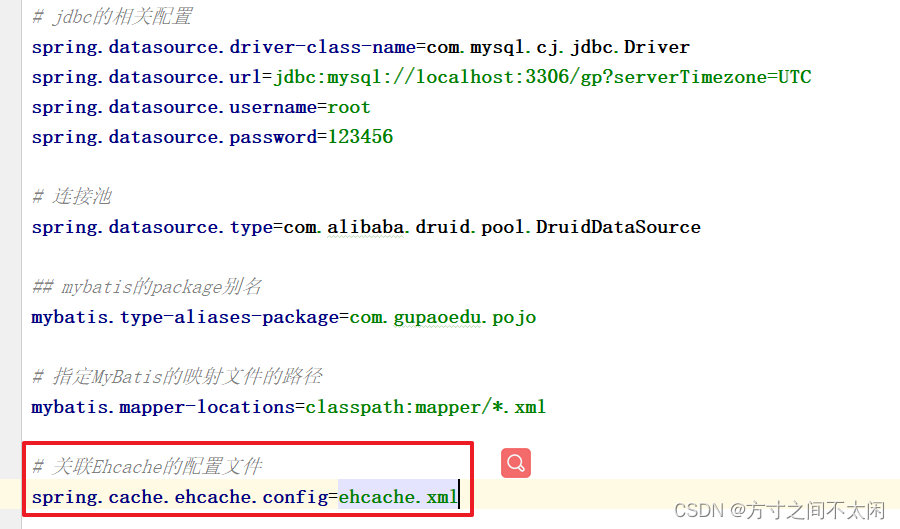
1.16.4 在需要开启换的位置通过 Cacheable 设置
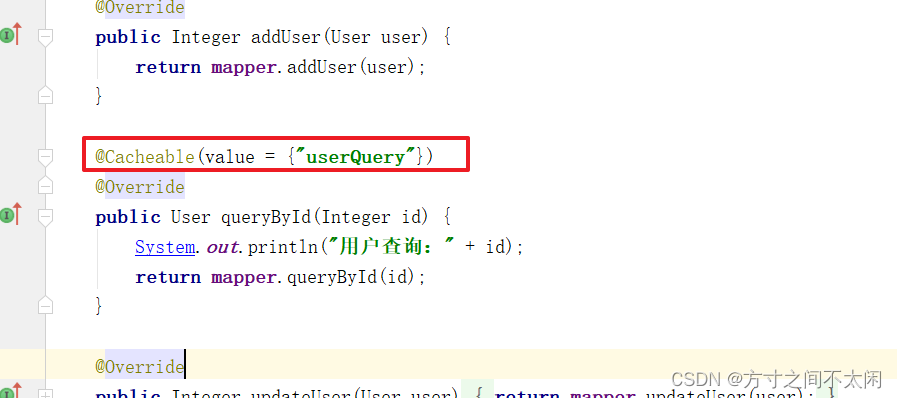
1.16.5 单元测试,放开缓存
<dependency>
<groupId>org.springframework.boot</groupId>
<artifactId>spring-boot-starter-test</artifactId>
</dependency>package com.gupaoedu.test;
import com.gupaoedu.service.IUserService;
import org.junit.Test;
import org.junit.runner.RunWith;
import org.springframework.beans.factory.annotation.Autowired;
import org.springframework.boot.test.context.SpringBootTest;
import org.springframework.cache.annotation.EnableCaching;
import org.springframework.test.context.junit4.SpringRunner;
@RunWith(SpringRunner.class)
@SpringBootTest
@EnableCaching// 放开缓存
public class Test01 {
@Autowired
private IUserService userService;
@Test
public void test01(){
userService.queryById(1);
userService.queryById(1);
}
}1.17 SpringBoot 整合 SpringDataRedis
1.17.1 添加相关的依赖
<dependency>
<groupId>org.springframework.boot</groupId>
<artifactId>spring-boot-starter-data-redis</artifactId>
</dependency>
<dependency>
<groupId>redis.clients</groupId>
<artifactId>jedis</artifactId>
<version>2.9.0</version>
</dependency>1.17.2 配置信息
spring.redis.jedis.pool.max-idle=10
spring.redis.jedis.pool.min-idle=5
spring.redis.jedis.pool.max-active=20
spring.redis.host=192.168.187.120
spring.redis.port=63791.17.3 Redis 的配置类
package com.gupaoedu.config;
import org.springframework.boot.context.properties.ConfigurationProperties;
import org.springframework.context.annotation.Bean;
import org.springframework.context.annotation.Configuration;
import org.springframework.data.redis.connection.jedis.JedisConnectionFactory;
import org.springframework.data.redis.core.RedisTemplate;
import org.springframework.data.redis.serializer.StringRedisSerializer;
import redis.clients.jedis.JedisPoolConfig;
@Configuration
public class RedisConfig {
/**
* 创建JedisPoolConfig对象
* @return
*/
@Bean
@ConfigurationProperties(prefix = "spring.redis.pool")
public JedisPoolConfig jedisPoolConfig(){
JedisPoolConfig config = new JedisPoolConfig();
System.out.println("默认值:" + config.getMaxIdle());
System.out.println("默认值:" + config.getMinIdle());
System.out.println("默认值:" + config.getMaxTotal());
return config;
}
@Bean
@ConfigurationProperties(prefix = "spring.redis.pool")
public JedisConnectionFactory jedisConnectionFactory(JedisPoolConfig config){
JedisConnectionFactory factory = new JedisConnectionFactory();
factory.setPoolConfig(config);
return factory;
}
@Bean
public RedisTemplate<String,Object> redisTemplate(JedisConnectionFactory jedisConnectionFactory){
RedisTemplate<String,Object> template = new RedisTemplate<>();
template.setConnectionFactory(jedisConnectionFactory);
// 设置 key的序列号器
template.setKeySerializer(new StringRedisSerializer());
// 设置 value的序列化器
template.setValueSerializer(new StringRedisSerializer());
return template;
}
}
1.17.4 单元测试
package com.gupaoedu;
import org.junit.Test;
import org.junit.runner.RunWith;
import org.springframework.beans.factory.annotation.Autowired;
import org.springframework.boot.test.context.SpringBootTest;
import org.springframework.data.redis.core.RedisTemplate;
import org.springframework.test.context.junit4.SpringRunner;
import redis.clients.jedis.Jedis;
@RunWith(SpringRunner.class)
@SpringBootTest
public class GpSpringbootRedisDemoApplicationTests {
@Autowired
private RedisTemplate<String,Object> template;
/**
* 添加一个简单的字符串
*/
@Test
public void test01() {
this.template.opsForValue().set("name","bobo");
}
}package com.gupaoedu;
import com.gupaoedu.pojo.User;
import org.junit.Test;
import org.junit.runner.RunWith;
import org.springframework.beans.factory.annotation.Autowired;
import org.springframework.boot.test.context.SpringBootTest;
import org.springframework.data.redis.core.RedisTemplate;
import org.springframework.data.redis.serializer.Jackson2JsonRedisSerializer;
import org.springframework.data.redis.serializer.JdkSerializationRedisSerializer;
import org.springframework.test.context.junit4.SpringRunner;
import redis.clients.jedis.Jedis;
@RunWith(SpringRunner.class)
@SpringBootTest
public class GpSpringbootRedisDemoApplicationTests {
@Autowired
private RedisTemplate<String,Object> template;
/**
* 添加一个简单的字符串
*/
@Test
public void test01() {
this.template.opsForValue().set("name","bobo");
}
@Test
public void test02() {
System.out.println(template.opsForValue().get("name"));
}
/**
* 将User对象序列化为一个字符串存储
*/
@Test
public void test03(){
User user = new User(1,"张三","湖南长沙");
// 设置序列化器
template.setValueSerializer(new JdkSerializationRedisSerializer());
template.opsForValue().set("user",user);
}
/**
* 将Redis中存储的User对象反序列化出来
*/
@Test
public void test04(){
template.setValueSerializer(new JdkSerializationRedisSerializer());
User user = (User) this.template.opsForValue().get("user");
System.out.println(user);
}
/**
* 将User对象转换为JSON对象存储
*/
@Test
public void test05(){
User user = new User(2,"李四","湖南长沙");
template.setValueSerializer(new Jackson2JsonRedisSerializer<>(User.class));
template.opsForValue().set("userJson",user);
}
/**
* 将Redis中存储的JSON数据取出转换为User对象
*/
@Test
public void test06(){
template.setValueSerializer(new Jackson2JsonRedisSerializer<>(User.class));
User user = (User) template.opsForValue().get("userJson");
System.out.println(user);
}
}1.18 SpringBoot 整合 Scheduled
Scheduled 定时任务,Spring3.0 之后就提供的有。
1.18.1 添加相关的依赖
<!-- 添加 Scheduled 坐标 -->
<dependency>
<groupId>org.springframework</groupId>
<artifactId>spring-context-support</artifactId>
<version>5.1.7.RELEASE</version>
</dependency>1.18.2 创建定时任务的方法
package com.gupaoedu.task;
import org.springframework.scheduling.annotation.Scheduled;
import org.springframework.stereotype.Component;
import java.util.Date;
@Component
public class MyScheduledTask {
/**
* 定时任务的方法
*/
@Scheduled(cron = "0/2 * * * * ?")
public void doSome(){
System.out.println("定时任务执行了...." + new Date());
}
}1.18.3 在启动器中放开 Scheduled
@SpringBootApplication
@EnableScheduling // 放开Scheduled定时任务
public class GpSpringbootScheduledDemoApplication {
public static void main(String[] args) {
SpringApplication.run(GpSpringbootScheduledDemoApplication.class, args);
}
}
cron 表达式 长度 6/7 位
> Seconds Minutes Hours Day Month Week Year
>
> Seconds Minutes Hours Day Month Week
例子
>@Scheduled(cron = “0 0 1 1 1 ?”)//每年一月的一号的 1:00:00 执行一次
>
>@Scheduled(cron = “0 0 1 1 1,6 ?”) //一月和六月的一号的 1:00:00 执行一次
>
>@Scheduled(cron = “0 0 1 1 1,4,7,10 ?”) //每个季度的第一个月的一号的 1:00:00 执行一次
>
>@Scheduled(cron = “0 0 1 1 * ?”)//每月一号 1:00:00 执行一次
>
>@Scheduled(cron=“0 0 1 * * *”) //每天凌晨 1 点执行一次
>
>@Scheduled(cron = “0 0 1 1 1,6 ?”) //一月和六月的一号的 1:00:00 执行一次
>
>@Scheduled(cron = “0 0 1 1 1,4,7,10 ?”) //每个季度的第一个月的一号的 1:00:00 执行一次
>
>@Scheduled(cron = “0 0 1 1 * ?”)//每月一号 1:00:00 执行一次
>
>@Scheduled(cron=“0 0 1 * * *”) //每天凌晨 1 点执行一次
1.19 SpringBoot 整合 Quartz
| 组成 | 描述 |
| ------------------- | ---------------------------- |
| Job--任务 | 你要做什么事? |
| Trigger--触发器 | 你什么时候去做? |
| Scheduler--任务调度 | 你什么时候需要去做什么事情? |1.19.1 Quartz 基本使用
1. 依赖
<!-- Quartz 坐标 -->
<dependency>
<groupId>org.quartz-scheduler</groupId>
<artifactId>quartz</artifactId>
<version>2.2.1</version>
</dependency>2. 创建 Job
package com.gupaoedu.Job;
import org.quartz.Job;
import org.quartz.JobExecutionContext;
import org.quartz.JobExecutionException;
import java.util.Date;
public class MyJob implements Job {
/**
* 自定义的Job
* @param jobExecutionContext
* @throws JobExecutionException
*/
@Override
public void execute(JobExecutionContext jobExecutionContext) throws JobExecutionException {
System.out.println("quartz任务执行了..." + new Date());
}
}3. 测试
package com.gupaoedu.Job;
import org.quartz.*;
import org.quartz.impl.StdSchedulerFactory;
public class JobMain {
public static void main(String[] args) throws SchedulerException {
// 1.创建Job对象
JobDetail job = JobBuilder.newJob(MyJob.class).build();
// 2.创建Trigger
Trigger trigger = TriggerBuilder
.newTrigger()
.withSchedule(CronScheduleBuilder.cronSchedule("0/2 * * * * ?"))
.build();
// 3.创建Scheduler对象
Scheduler scheduler = StdSchedulerFactory.getDefaultScheduler();
scheduler.scheduleJob(job,trigger);
// 启动
scheduler.start();
}
}1.19.2 SpringBoot 整合 Quartz
1. 添加对应的依赖
<!-- Quartz 坐标 -->
<dependency>
<groupId>org.quartz-scheduler</groupId>
<artifactId>quartz</artifactId>
<version>2.2.1</version>
<exclusions>
<exclusion>
<artifactId>slf4j-api</artifactId>
<groupId>org.slf4j</groupId>
</exclusion>
</exclusions>
</dependency>
<!-- 添加 Scheduled 坐标 -->
<dependency>
<groupId>org.springframework</groupId>
<artifactId>spring-context-support</artifactId>
</dependency>
<!-- Sprng tx 坐标 -->
<dependency>
<groupId>org.springframework</groupId>
<artifactId>spring-tx</artifactId>
</dependency>
2. 创建对应的 Quartz 配置类
package com.gupaoedu.config;
import com.gupaoedu.Job.MyJob;
import org.springframework.context.annotation.Bean;
import org.springframework.context.annotation.Configuration;
import org.springframework.scheduling.quartz.CronTriggerFactoryBean;
import org.springframework.scheduling.quartz.JobDetailFactoryBean;
import org.springframework.scheduling.quartz.SchedulerFactoryBean;
import org.springframework.scheduling.quartz.SimpleTriggerFactoryBean;
@Configuration
public class QuartzConfig {
/**
* 创建Job对象
* @return
*/
@Bean
public JobDetailFactoryBean jobDetailFactoryBean(){
JobDetailFactoryBean factoryBean = new JobDetailFactoryBean();
// 关联 Job类
factoryBean.setJobClass(MyJob.class);
return factoryBean;
}
/**
* 创建Trigger对象
* @return
*/
@Bean
public SimpleTriggerFactoryBean simpleTriggerFactoryBean(JobDetailFactoryBean jobDetailFactoryBean){
SimpleTriggerFactoryBean factoryBean = new SimpleTriggerFactoryBean();
// 关联JobDetail对象
factoryBean.setJobDetail(jobDetailFactoryBean.getObject());
// 设置间隔时间
factoryBean.setRepeatInterval(2000);
// 设置重复次数
factoryBean.setRepeatCount(3);
return factoryBean;
}
/**
* 创建Trigger对象 Cron表达式
* @return
*/
@Bean
public CronTriggerFactoryBean cronTriggerFactoryBean(JobDetailFactoryBean jobDetailFactoryBean){
CronTriggerFactoryBean factoryBean = new CronTriggerFactoryBean();
factoryBean.setJobDetail(jobDetailFactoryBean.getObject());
// 设置触发的时间
factoryBean.setCronExpression("0/3 * * * * ?");
return factoryBean;
}
/**
* 创建对应的Scheduler对象
* @param cronTriggerFactoryBean
* @return
*/
@Bean
public SchedulerFactoryBean schedulerFactoryBean(CronTriggerFactoryBean cronTriggerFactoryBean){
SchedulerFactoryBean factoryBean = new SchedulerFactoryBean();
factoryBean.setTriggers(cronTriggerFactoryBean.getObject());
return factoryBean;
}
}3. 启动器中放开
package com.gupaoedu;
import org.springframework.boot.SpringApplication;
import org.springframework.boot.autoconfigure.SpringBootApplication;
import org.springframework.scheduling.annotation.EnableScheduling;
@SpringBootApplication
@EnableScheduling
public class GpSpringbootQuartzDemoApplication {
public static void main(String[] args) {
SpringApplication.run(GpSpringbootQuartzDemoApplication.class, args);
}
}1.20 SpringBoot 整合 SpringDataJPA
1.20.1 添加依赖
<dependencies>
<dependency>
<groupId>org.springframework.boot</groupId>
<artifactId>spring-boot-starter-web</artifactId>
</dependency>
<dependency>
<groupId>org.springframework.boot</groupId>
<artifactId>spring-boot-starter-test</artifactId>
<scope>test</scope>
</dependency>
<!-- springBoot的启动器 -->
<dependency>
<groupId>org.springframework.boot</groupId>
<artifactId>spring-boot-starter-data-jpa</artifactId>
</dependency>
<!-- mysql -->
<dependency>
<groupId>mysql</groupId>
<artifactId>mysql-connector-java</artifactId>
<version>5.1.47</version>
</dependency>
<!-- druid连接池 -->
<dependency>
<groupId>com.alibaba</groupId>
<artifactId>druid</artifactId>
<version>1.0.9</version>
</dependency>
</dependencies>
1.20.2 配置文件
# jdbc的相关配置
spring.datasource.driver-class-name=com.mysql.cj.jdbc.Driver
spring.datasource.url=jdbc:mysql://localhost:3306/gp?serverTimezone=UTC
spring.datasource.username=root
spring.datasource.password=123456
# 配置连接池信息
spring.datasource.type=com.alibaba.druid.pool.DruidDataSource
# 配置JPA的相关参数
spring.jpa.hibernate.ddl-auto=update
spring.jpa.show-sql=true
1.20.3 创建 POJO 对象
package com.gupaoedu.pojo;
import javax.persistence.*;
@Entity
@Table(name = "users")
public class User {
@Id
@GeneratedValue(strategy = GenerationType.IDENTITY)
@Column(name = "id")
private Integer id;
@Column(name = "name")
private String name;
@Column(name = "age")
private Integer age;
public Integer getId() {
return id;
}
public void setId(Integer id) {
this.id = id;
}
public String getName() {
return name;
}
public void setName(String name) {
this.name = name;
}
public Integer getAge() {
return age;
}
public void setAge(Integer age) {
this.age = age;
}
}1.20.4 创建 Repository 接口
package com.gupaoedu.dao;
import com.gupaoedu.pojo.User;
import org.springframework.data.jpa.repository.JpaRepository;
public interface UserRepository extends JpaRepository<User,Integer> {
}1.20.5 单元测试
package com.gupaoedu;
import com.gupaoedu.dao.UserRepository;
import com.gupaoedu.pojo.User;
import org.junit.Test;
import org.junit.runner.RunWith;
import org.springframework.beans.factory.annotation.Autowired;
import org.springframework.boot.test.context.SpringBootTest;
import org.springframework.test.context.junit4.SpringRunner;
@RunWith(SpringRunner.class)
@SpringBootTest
public class GpSpringbootJpaDemoApplicationTests {
@Autowired
private UserRepository repository;
@Test
public void contextLoads() {
User user = new User();
user.setName("gupao");
user.setAge(4);
repository.save(user);
}
}
